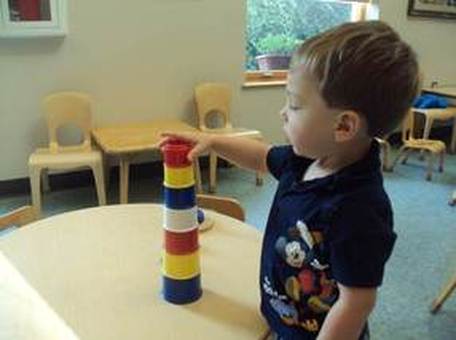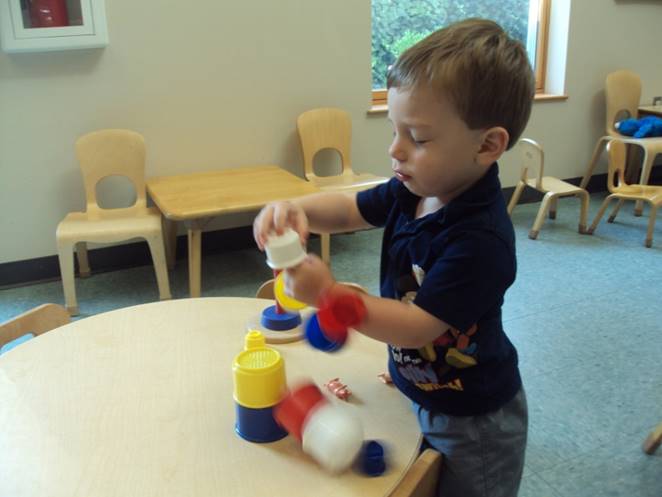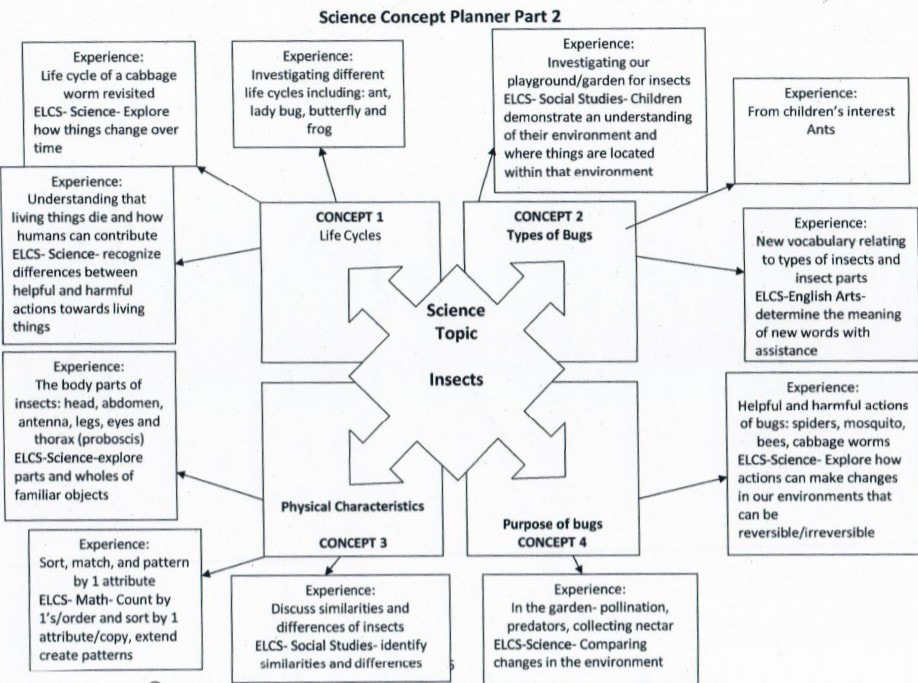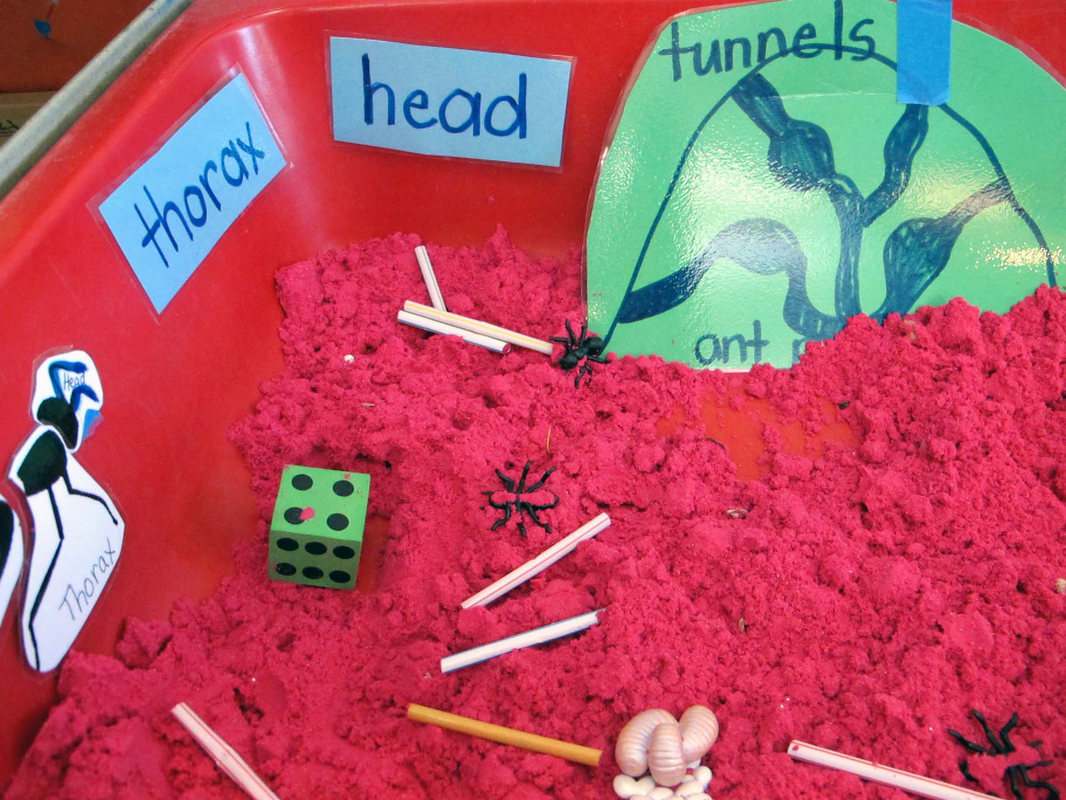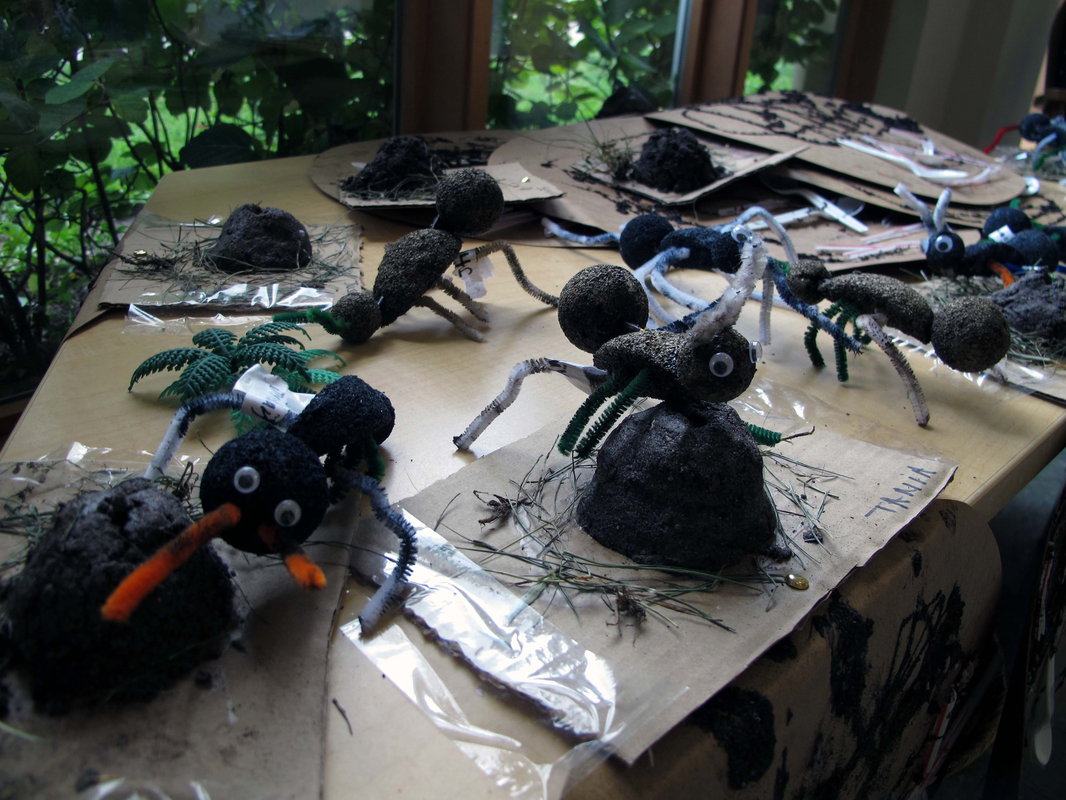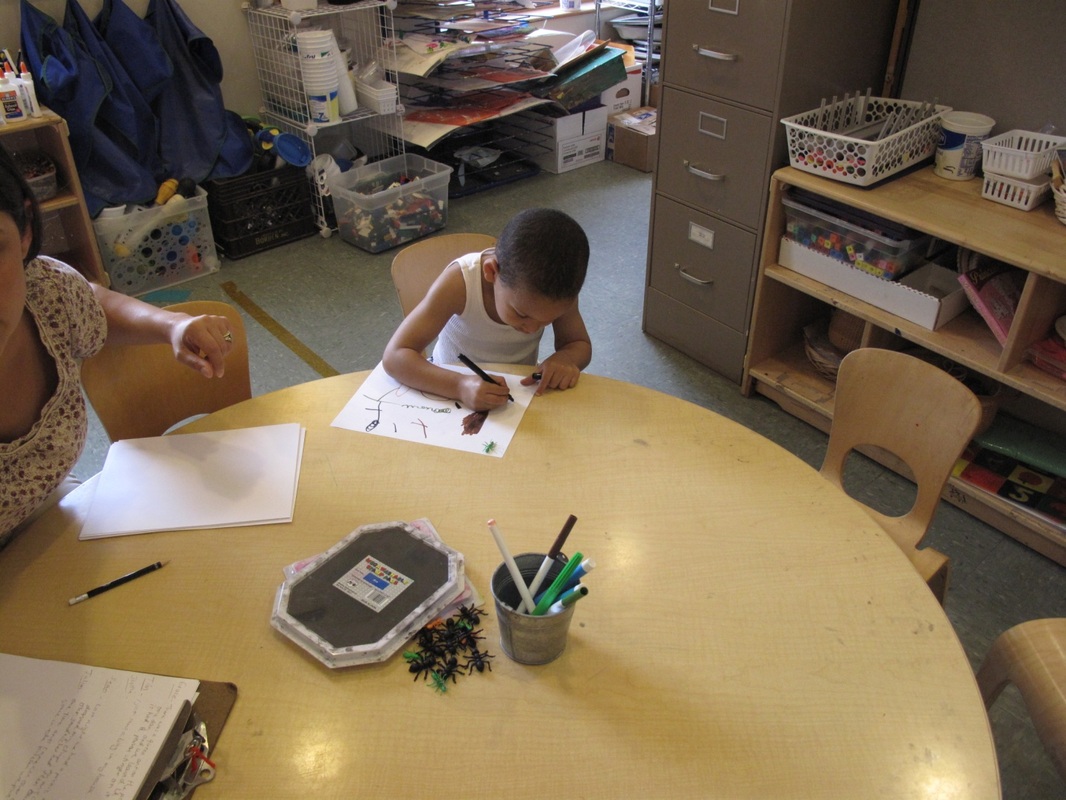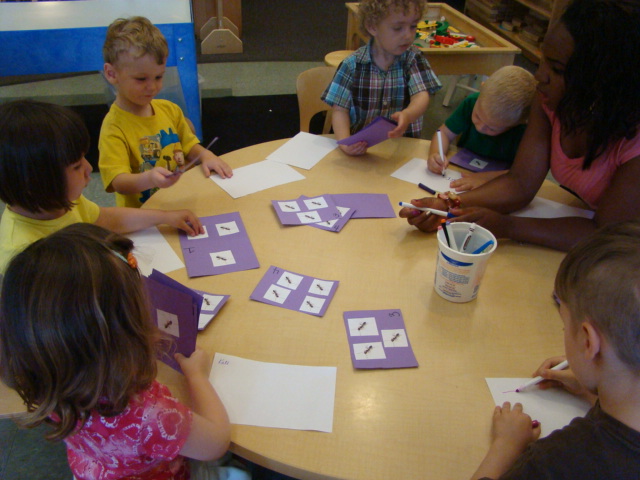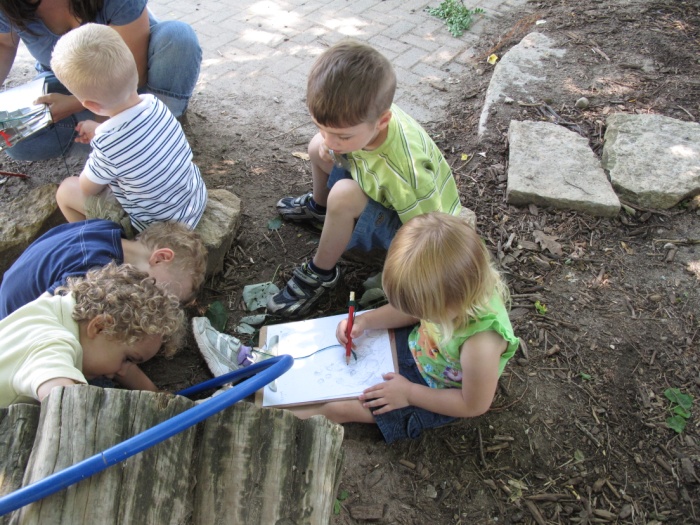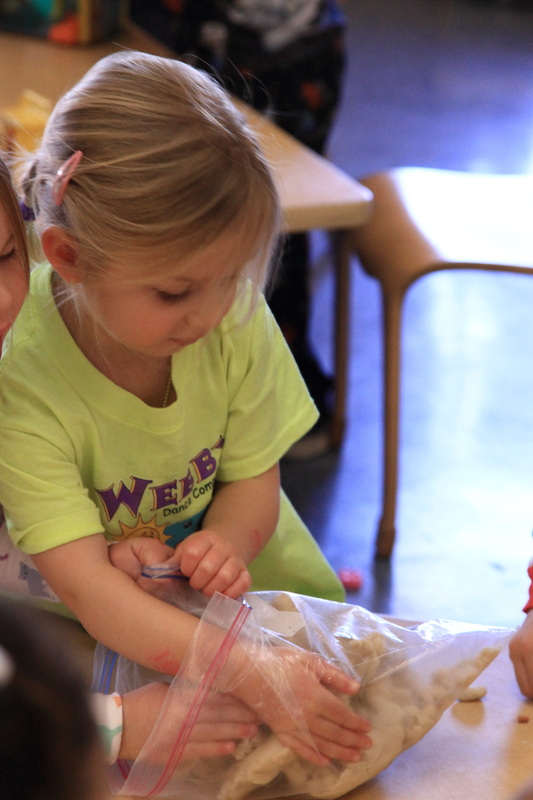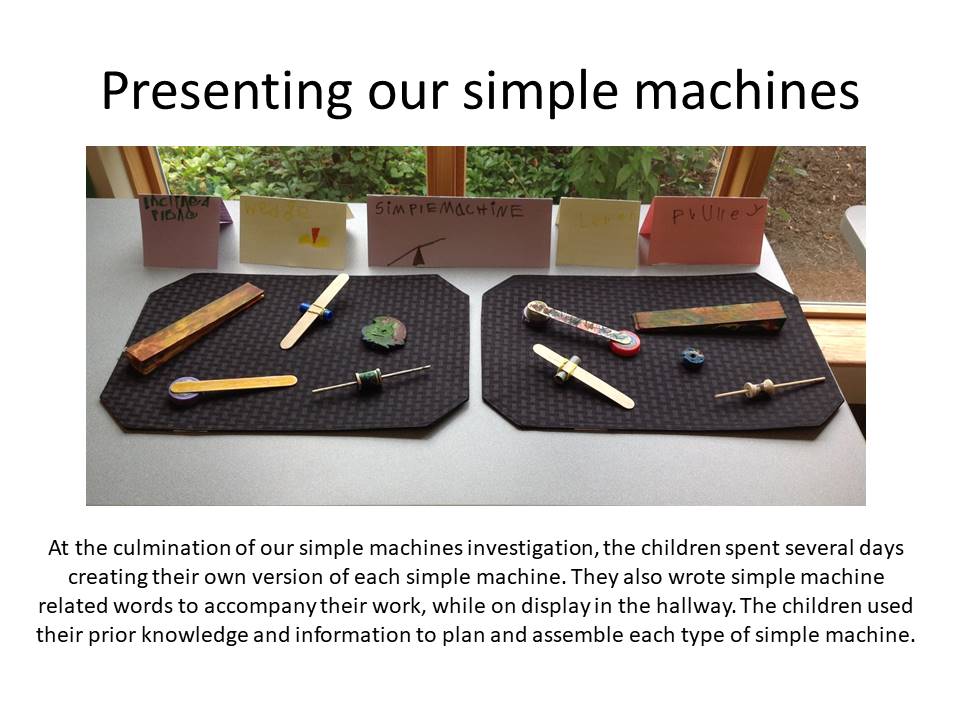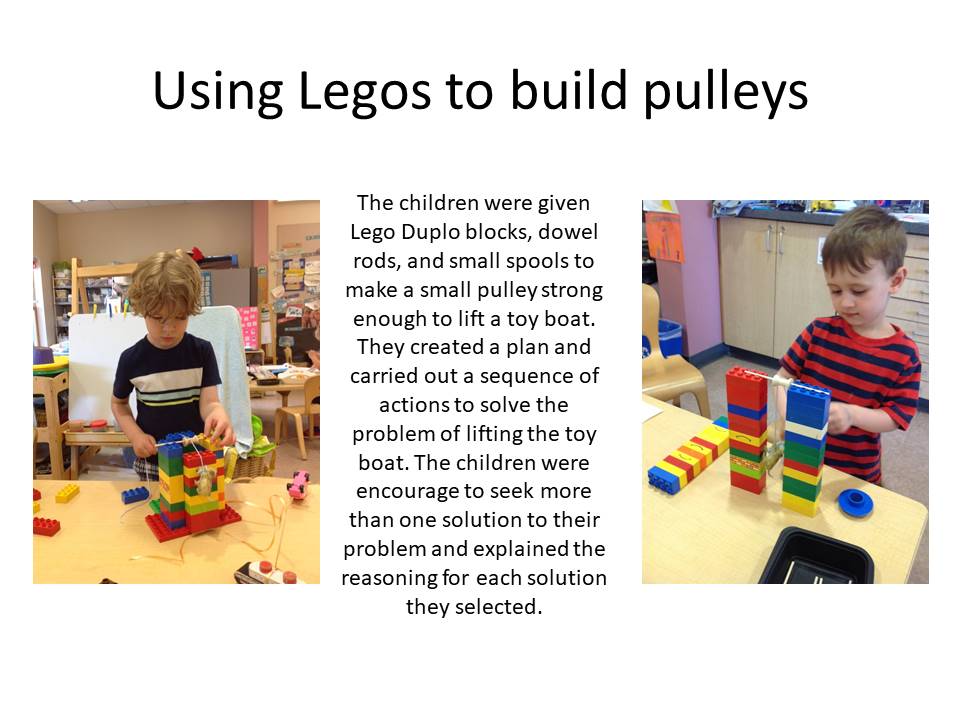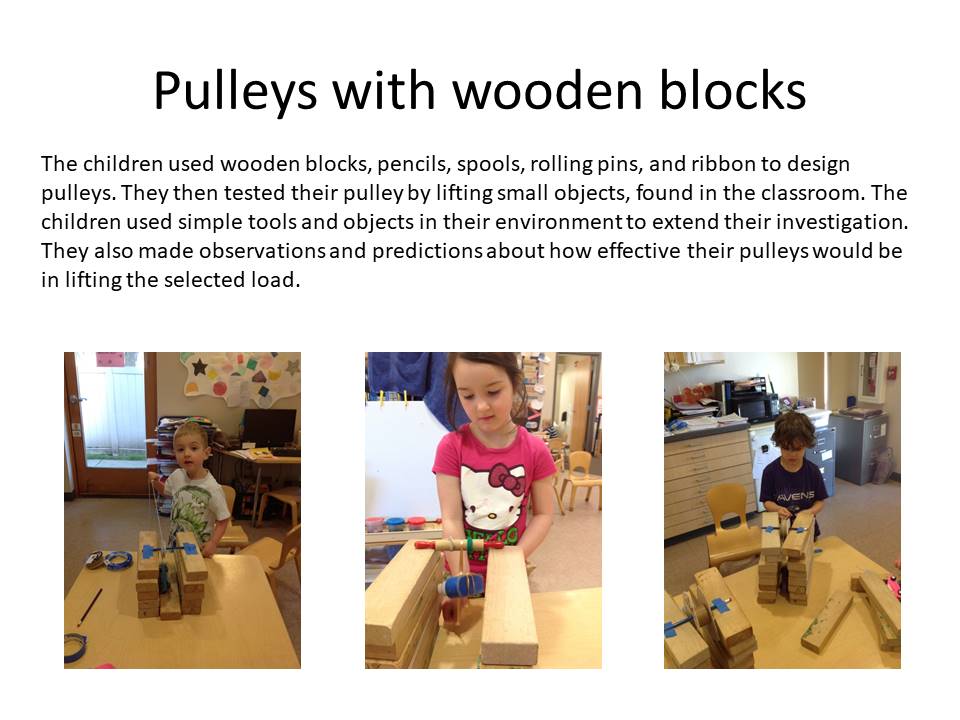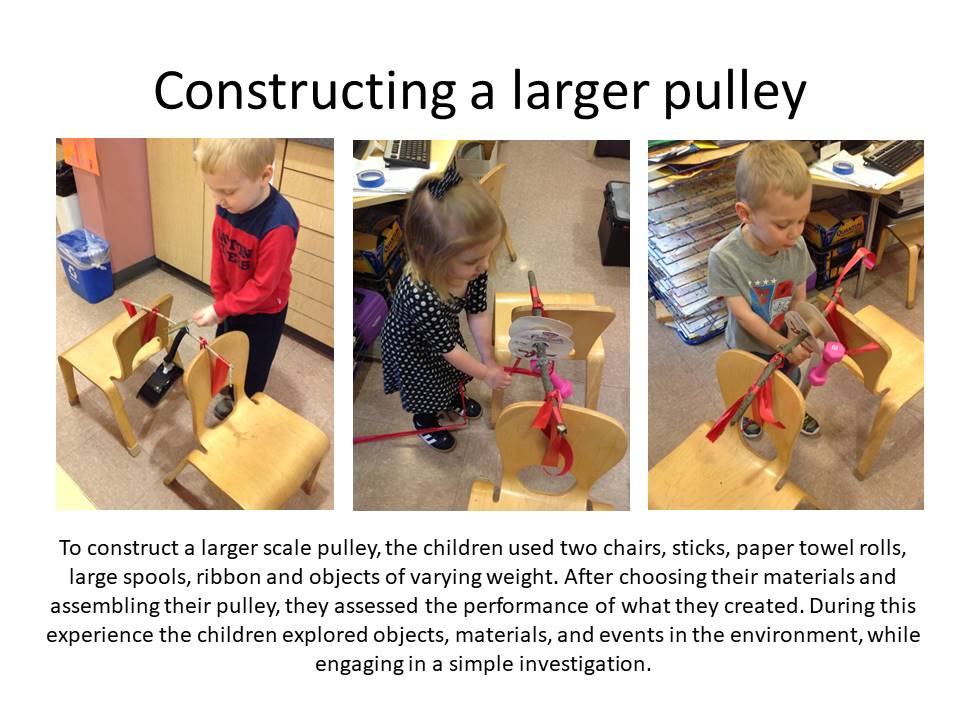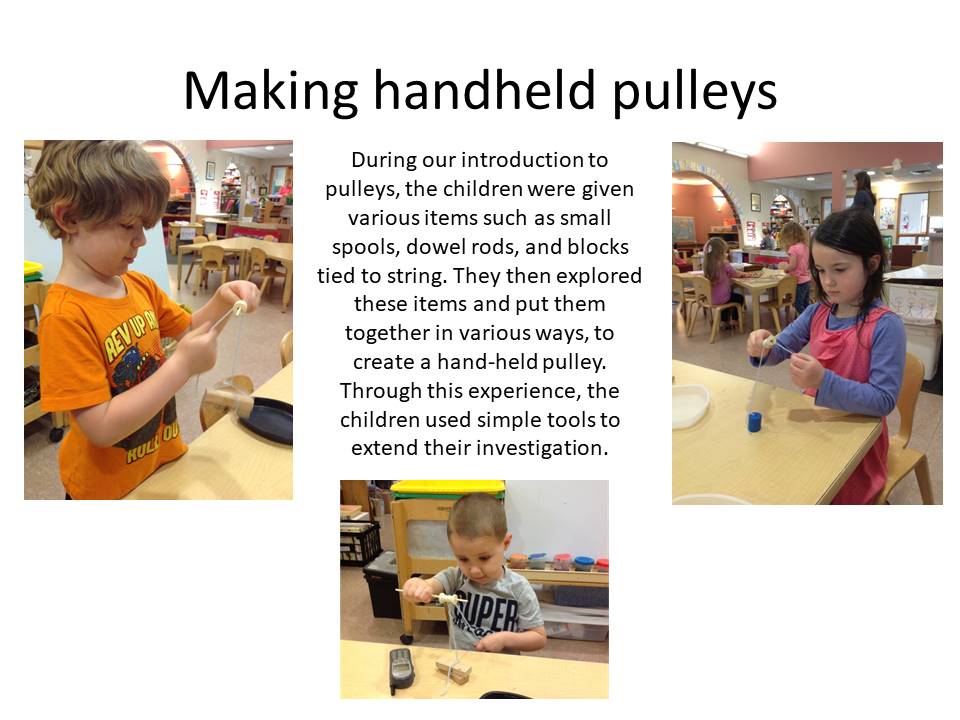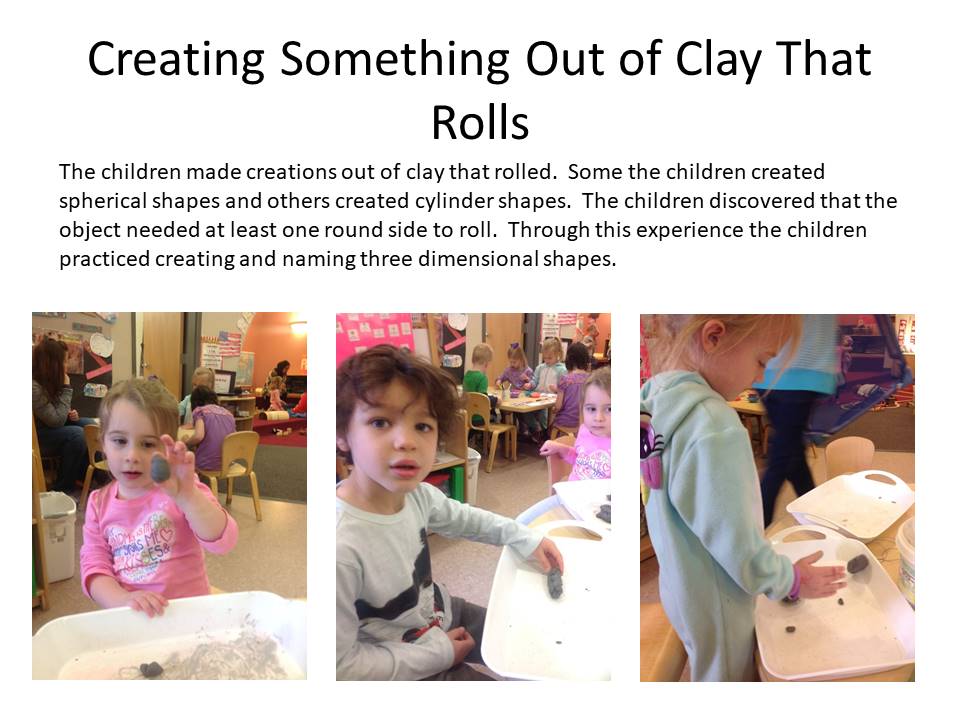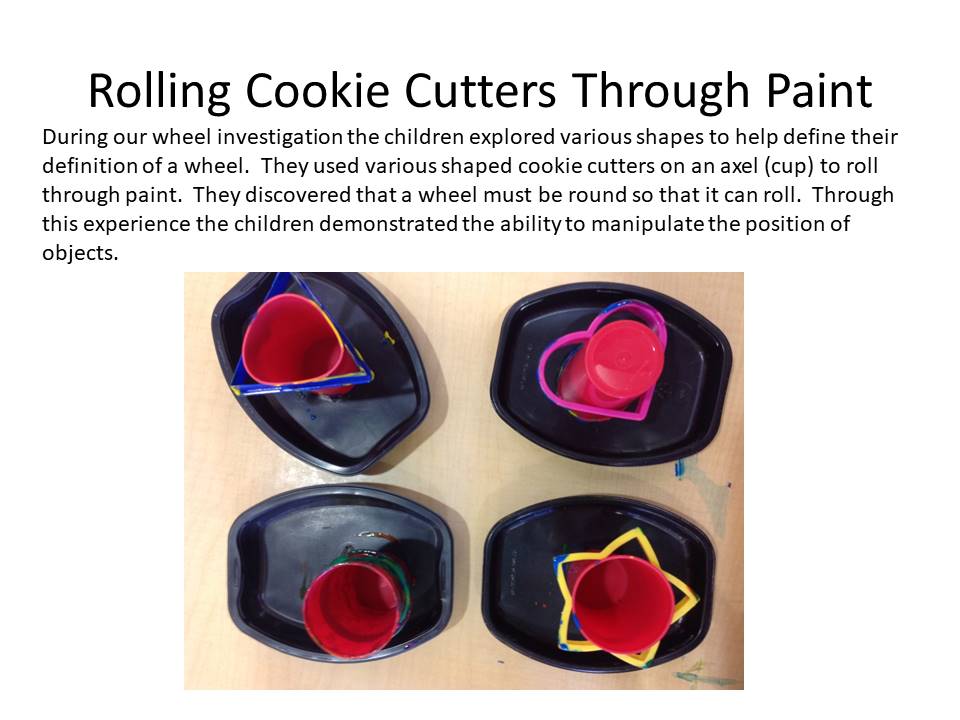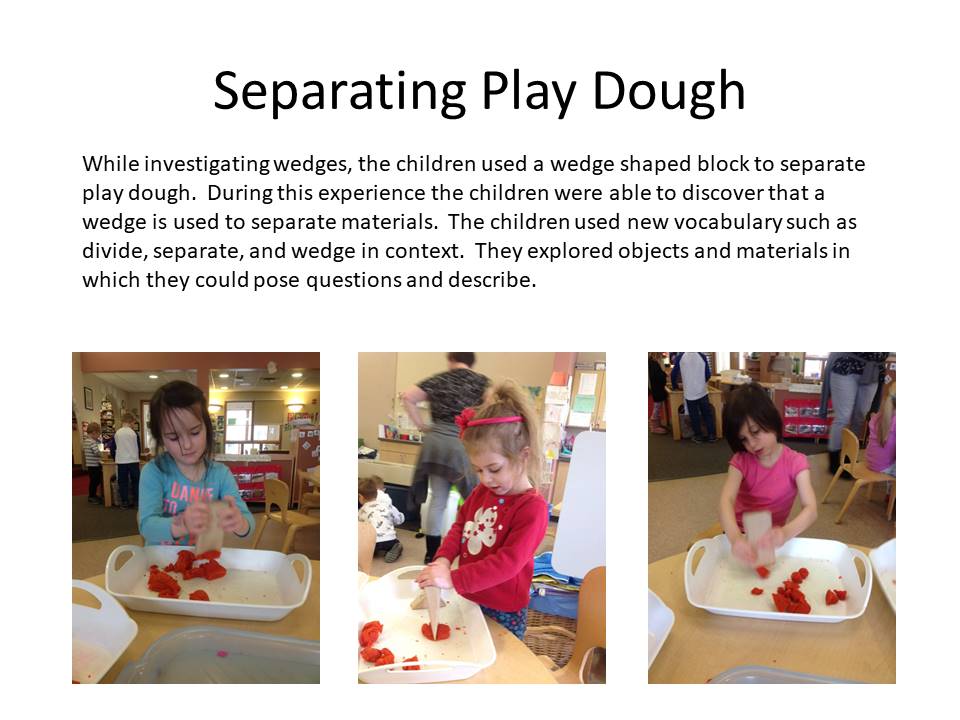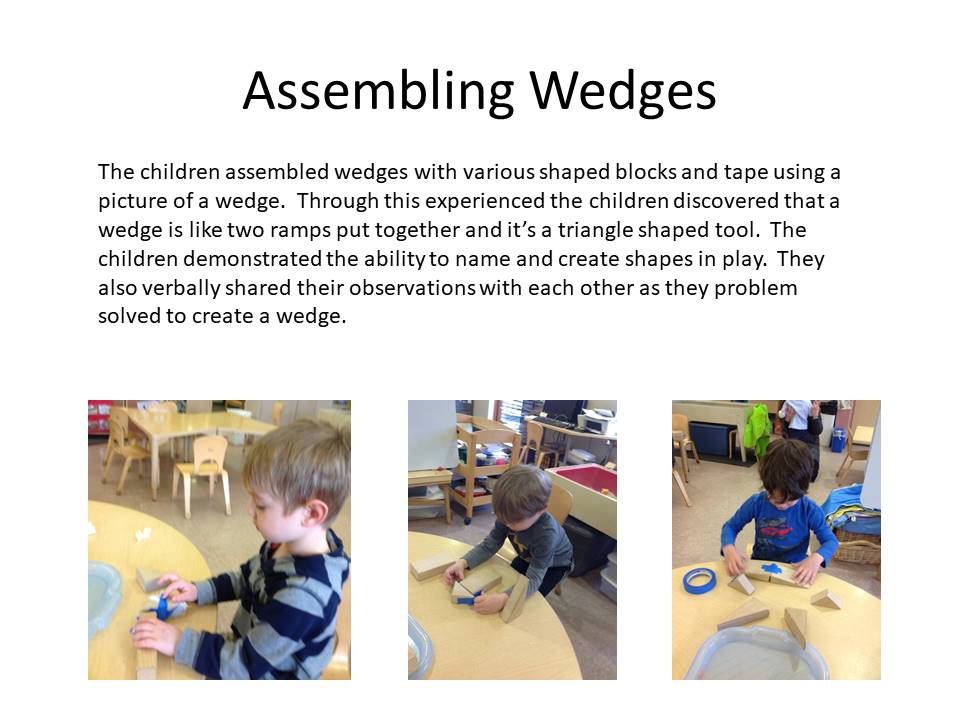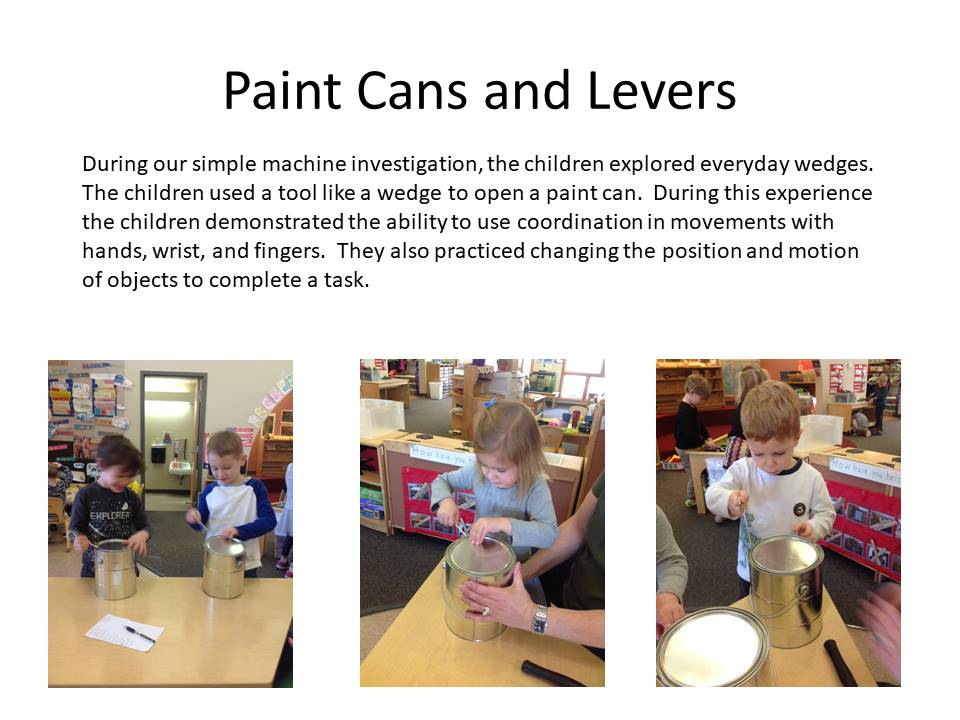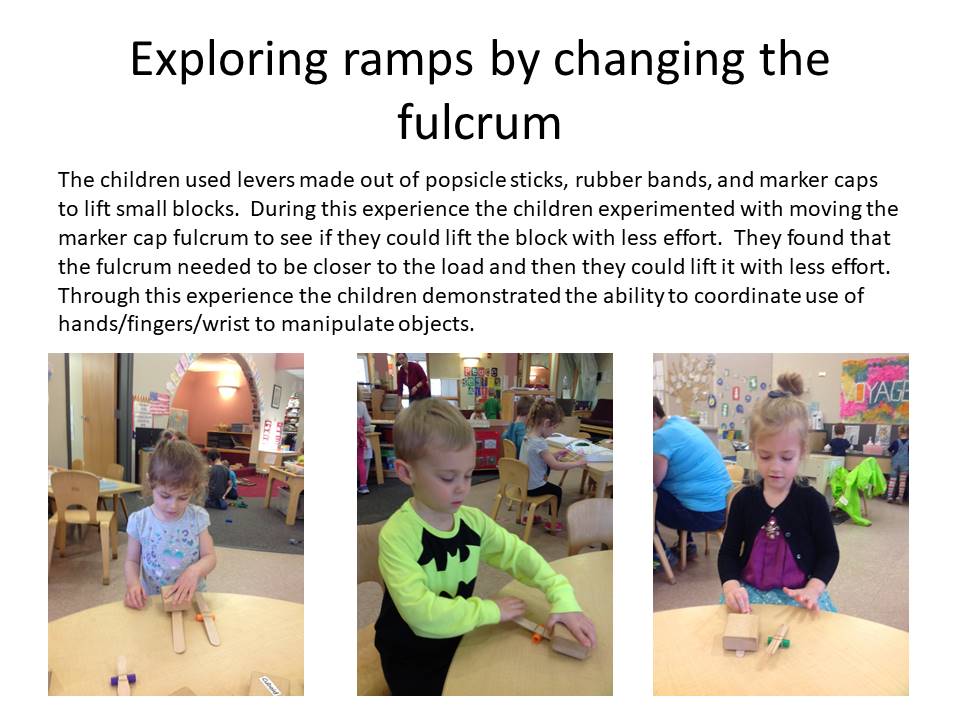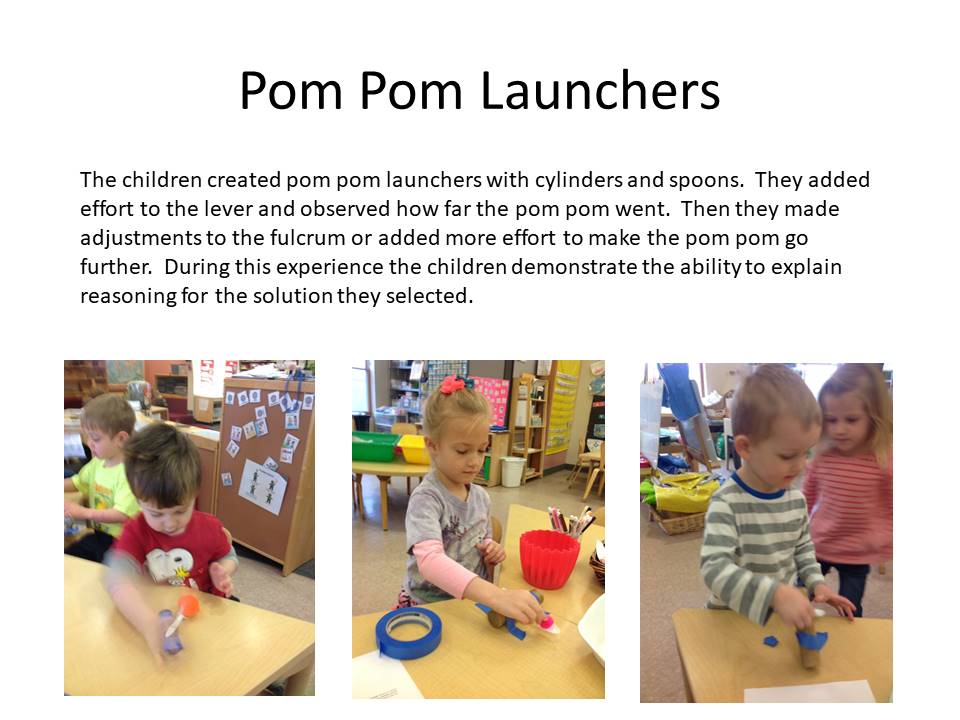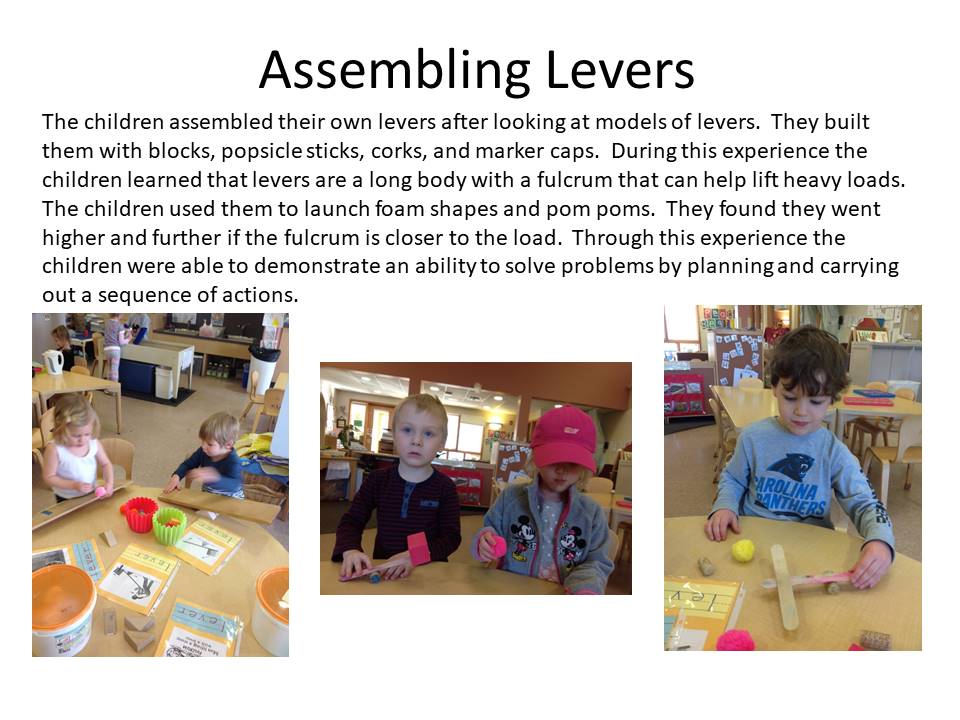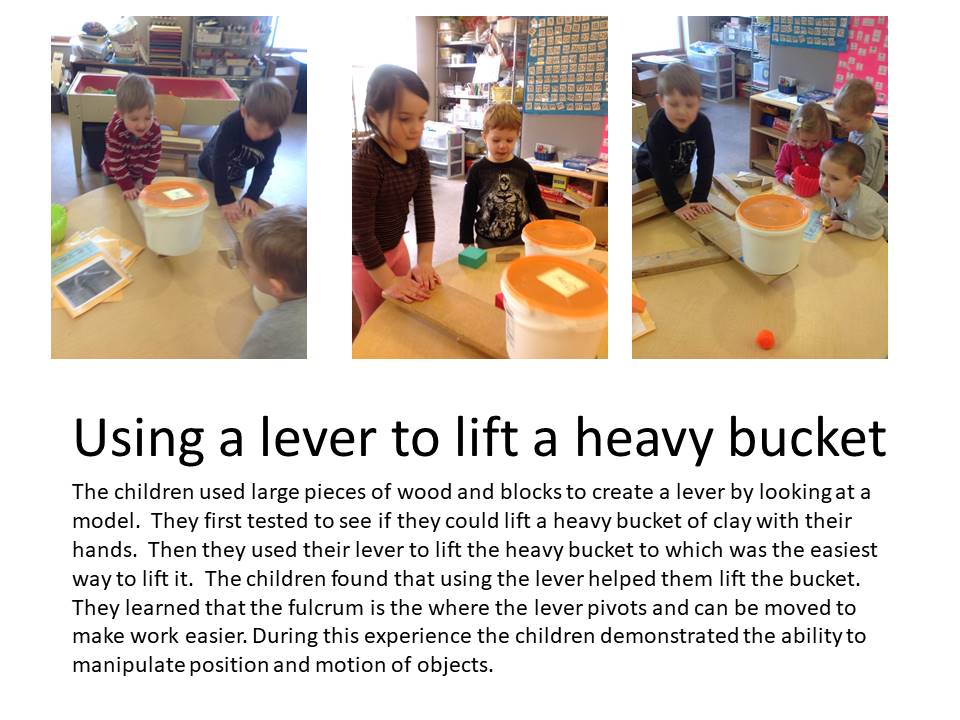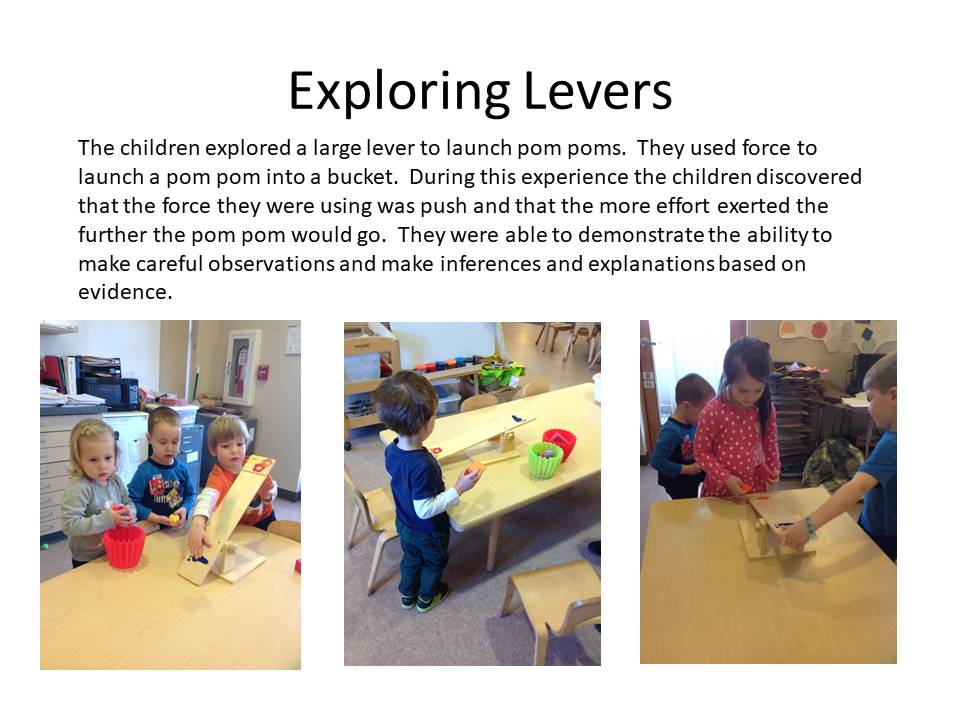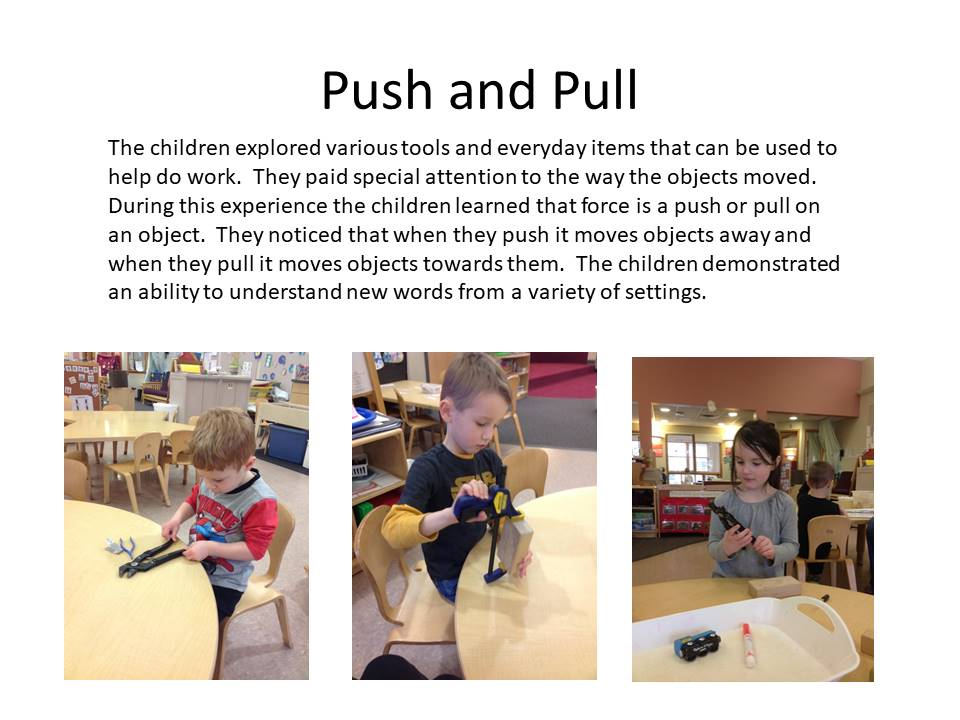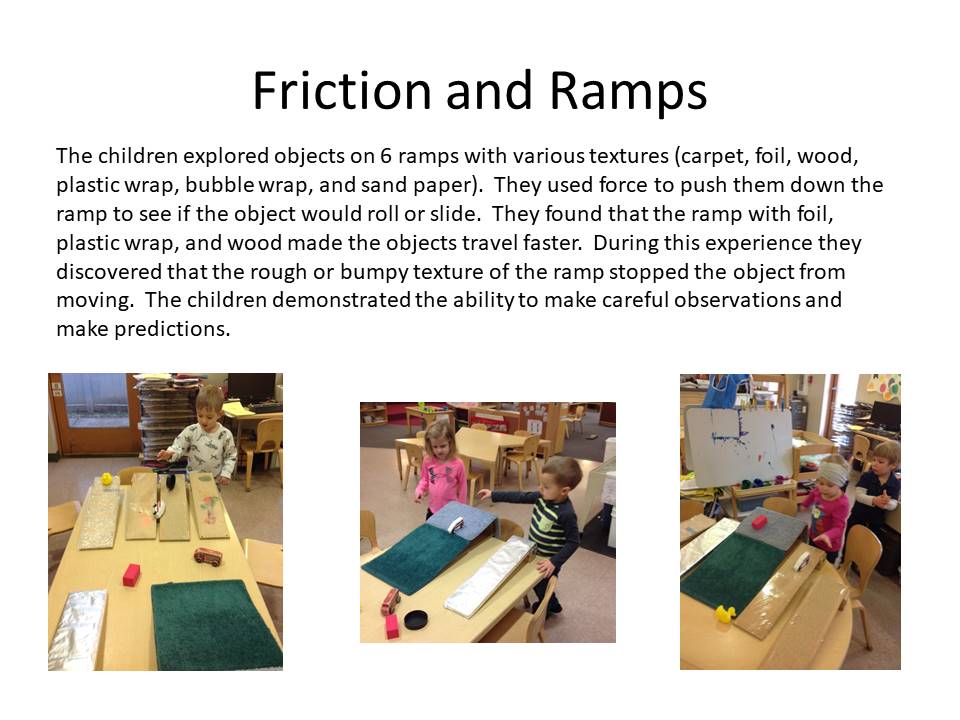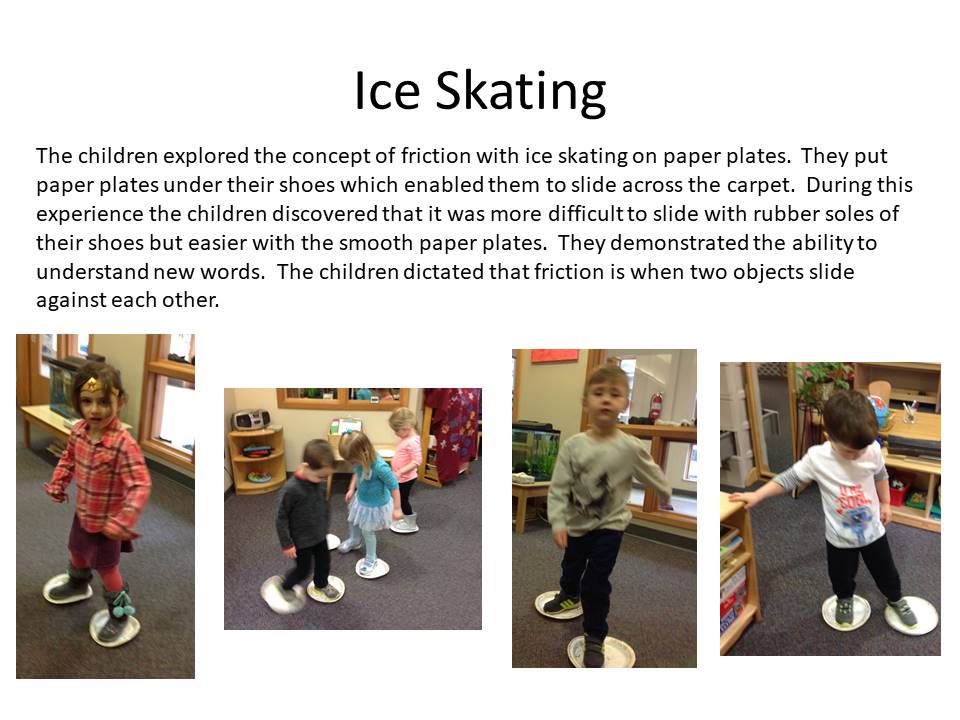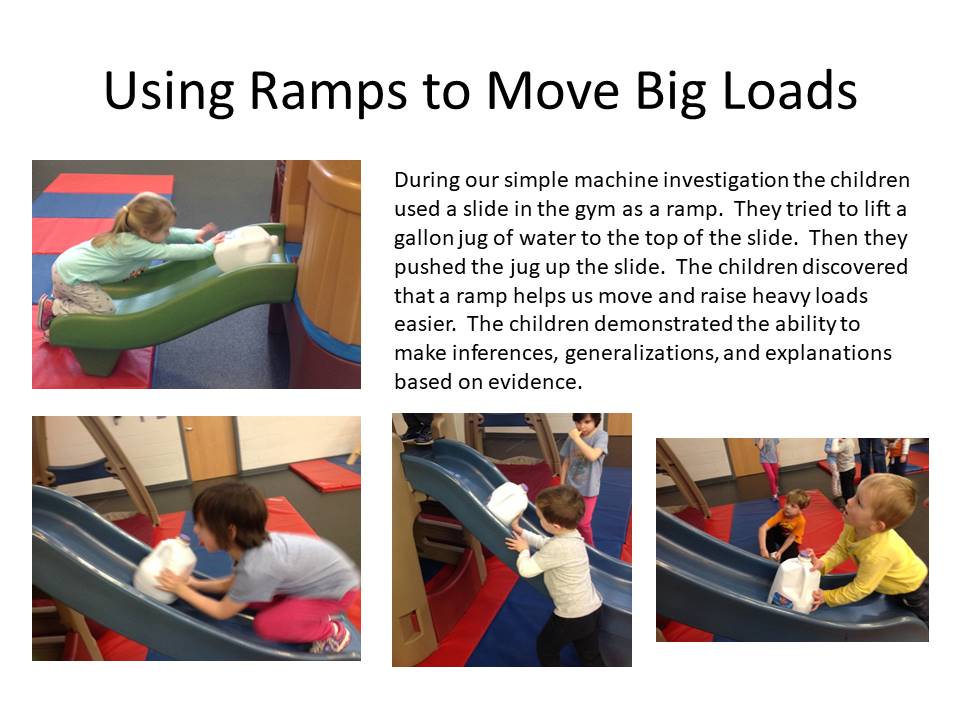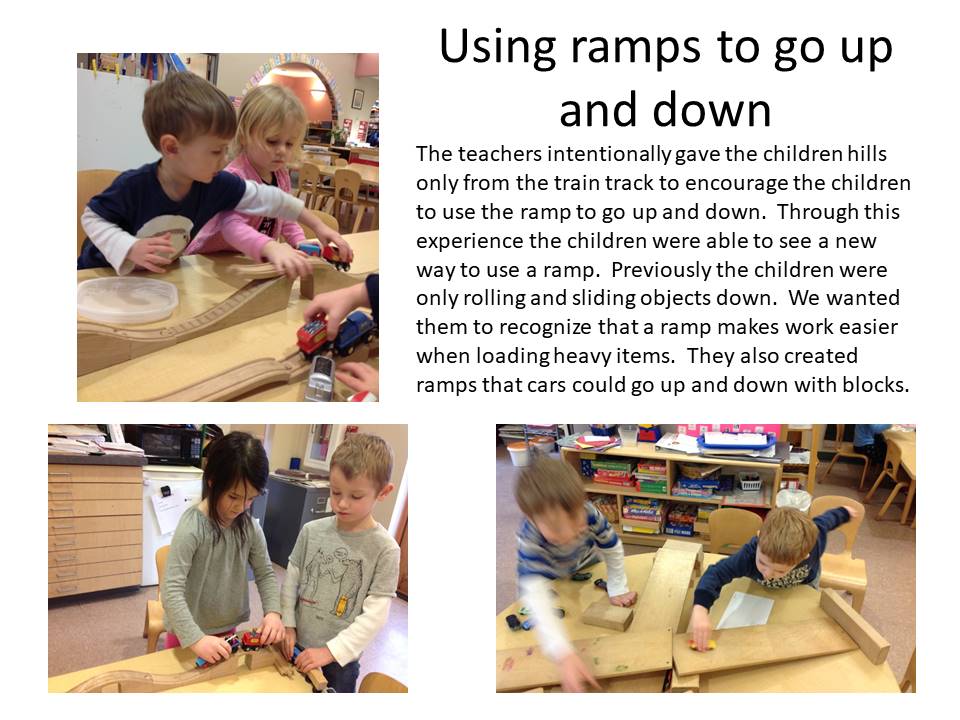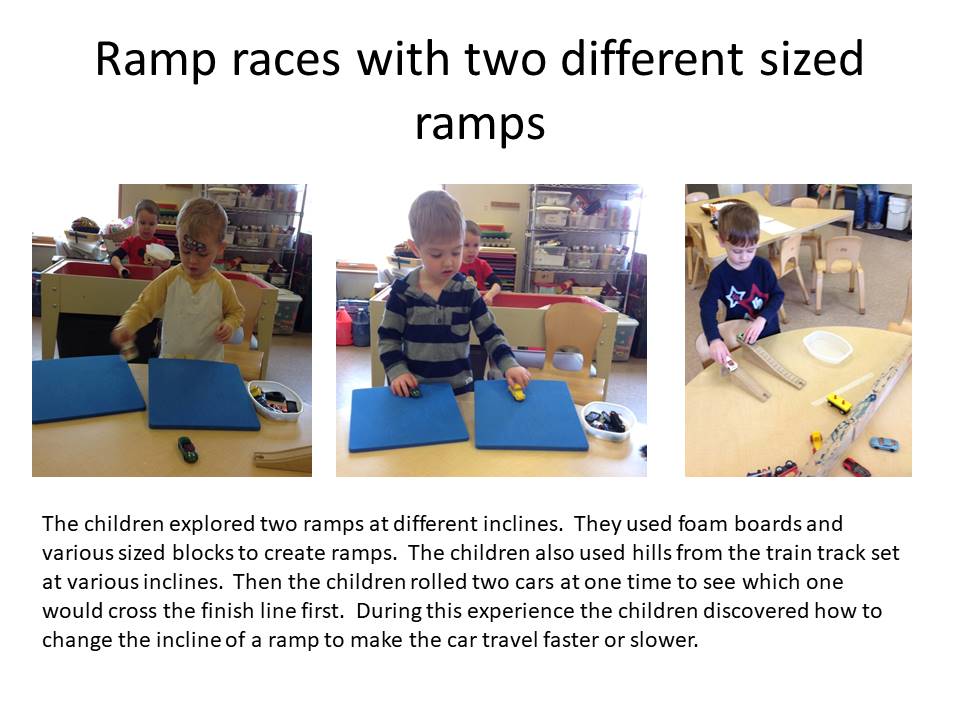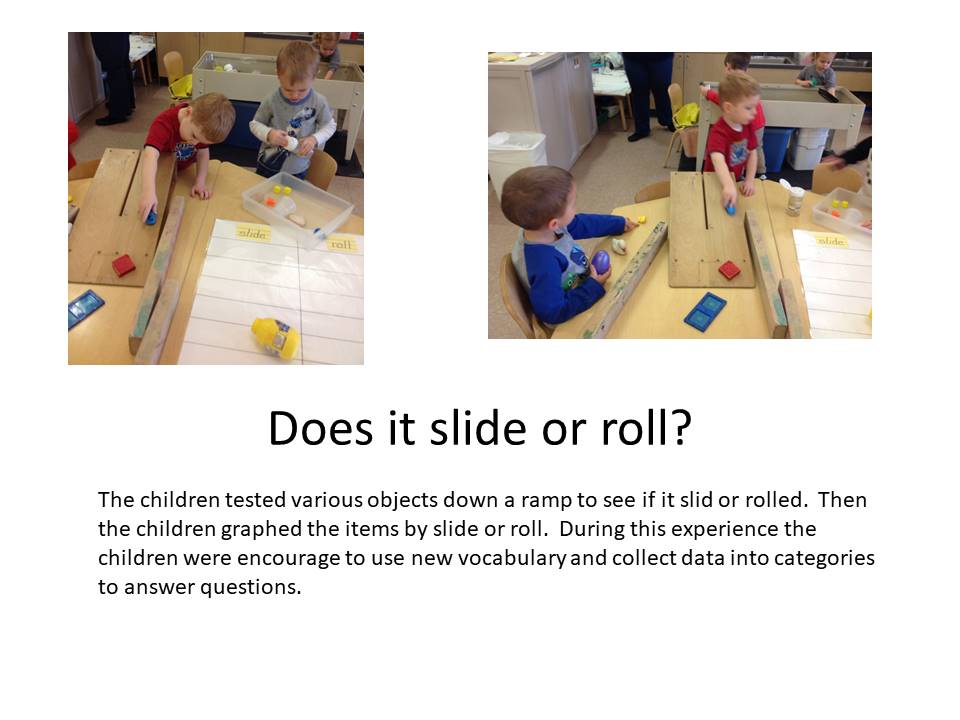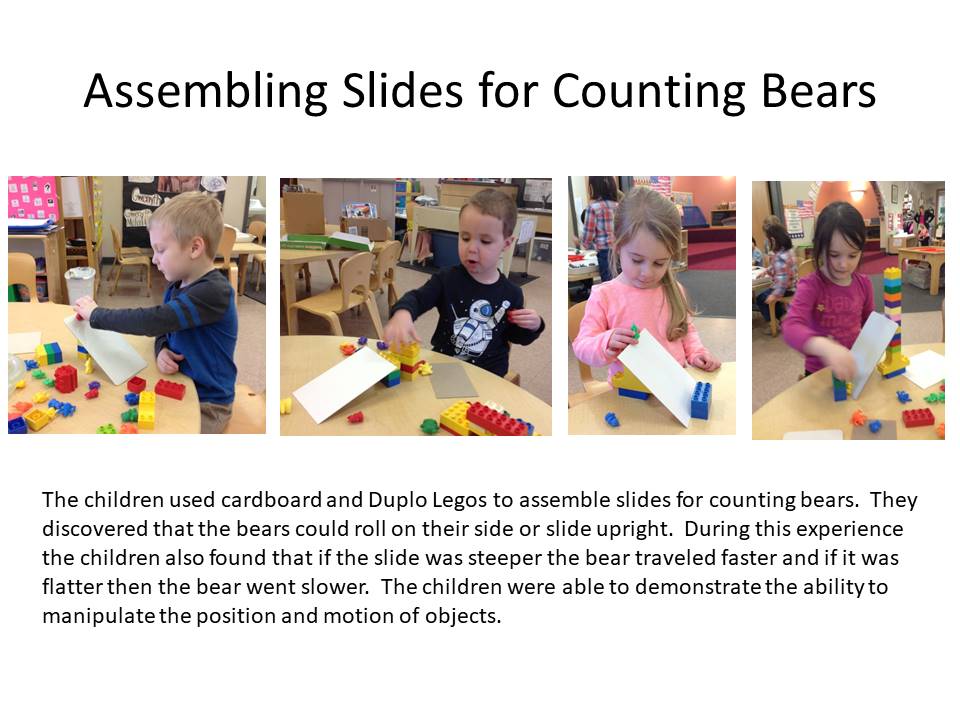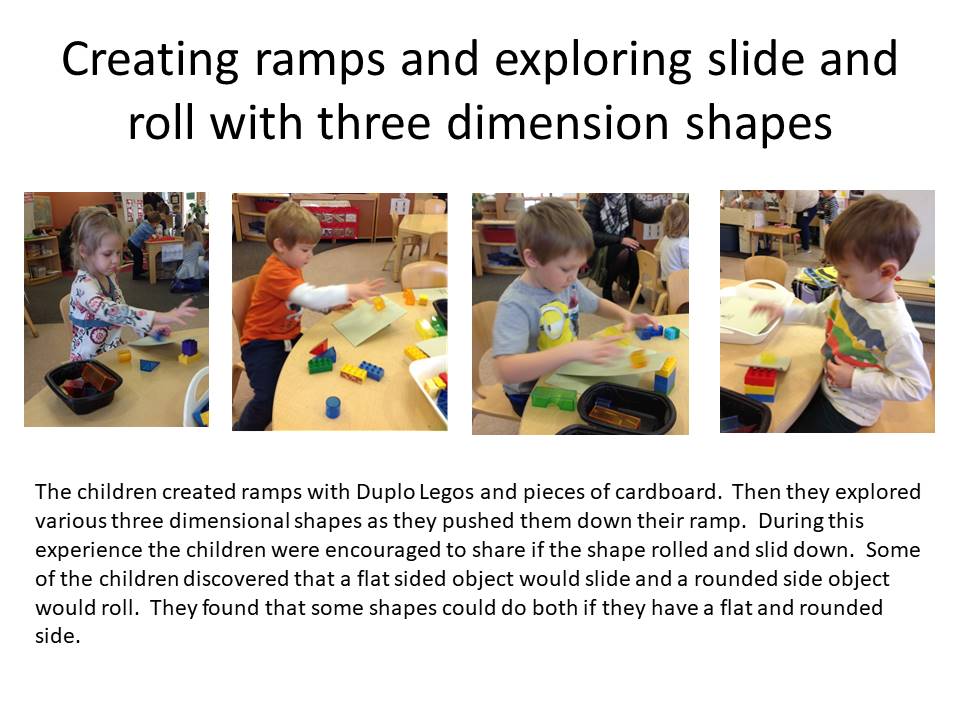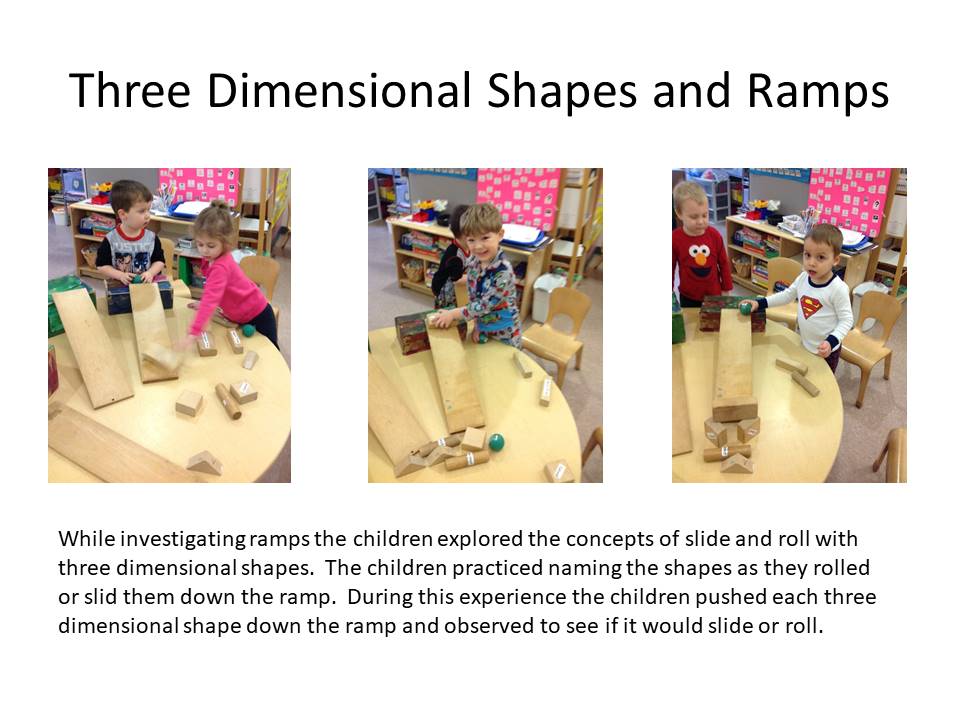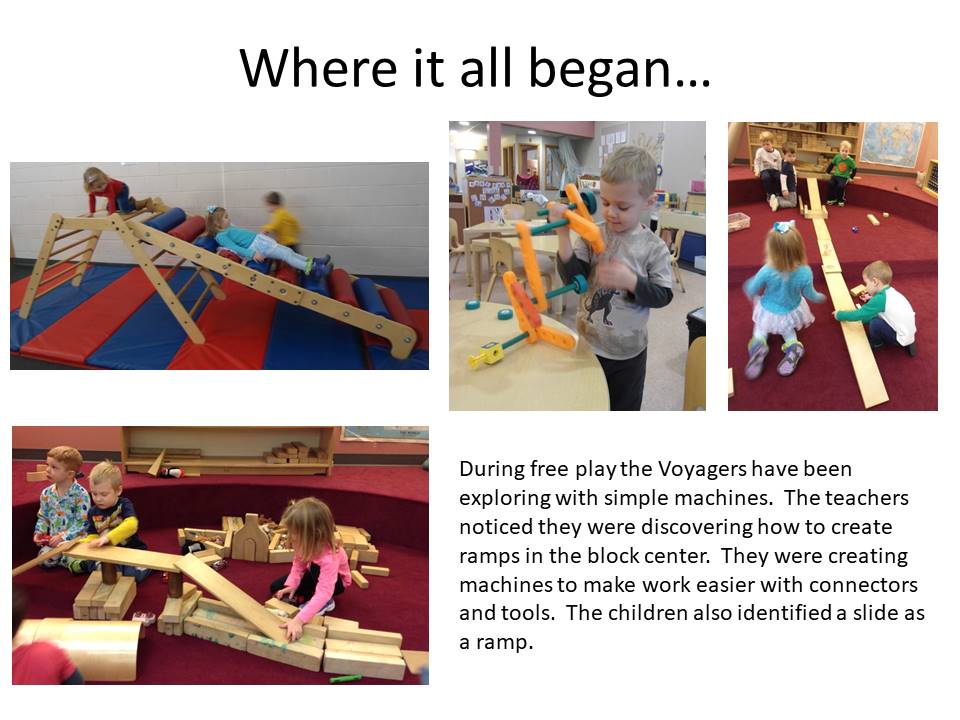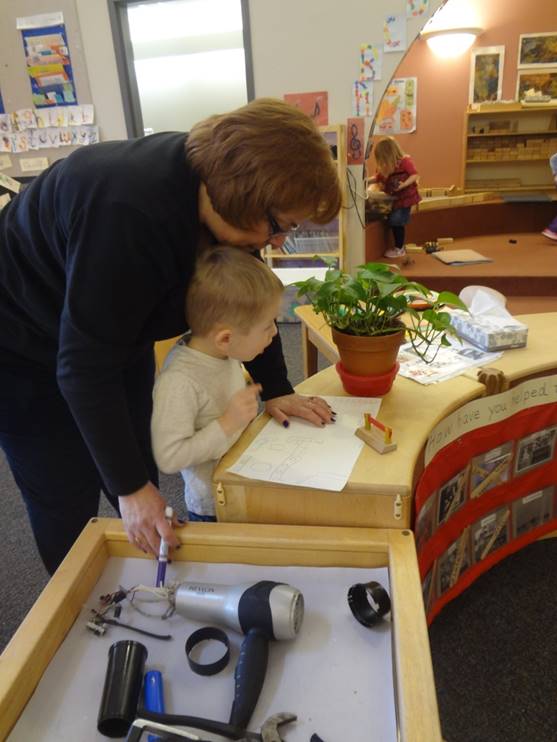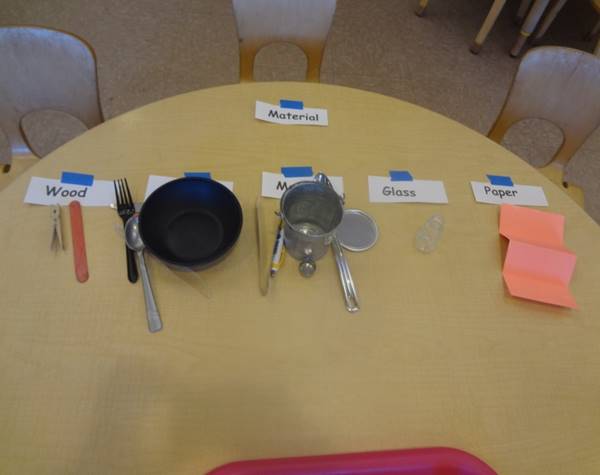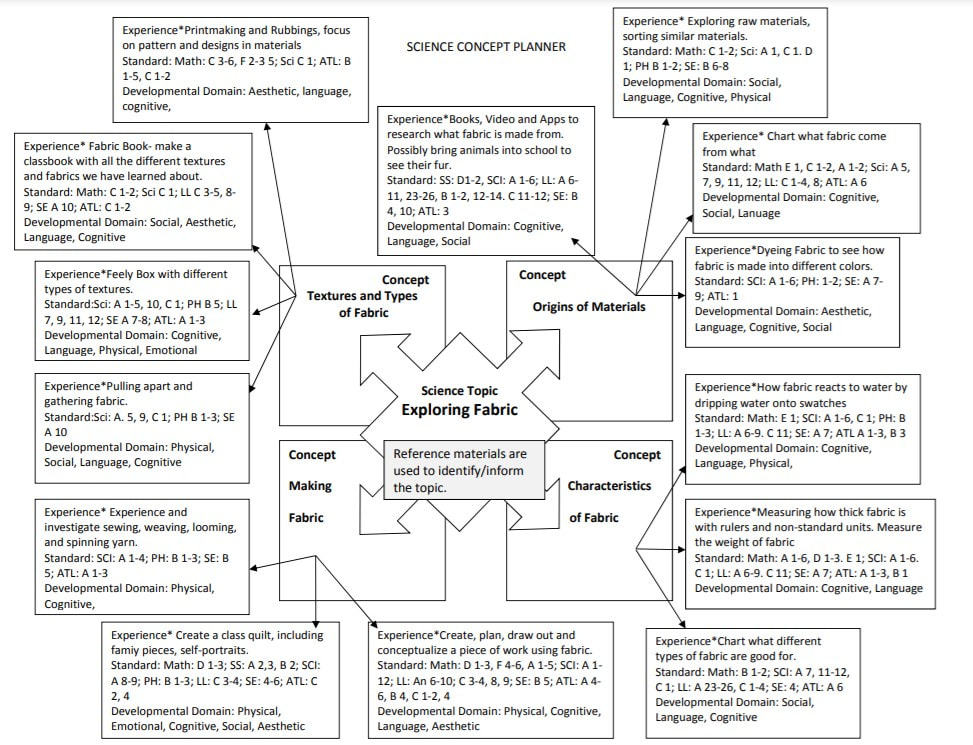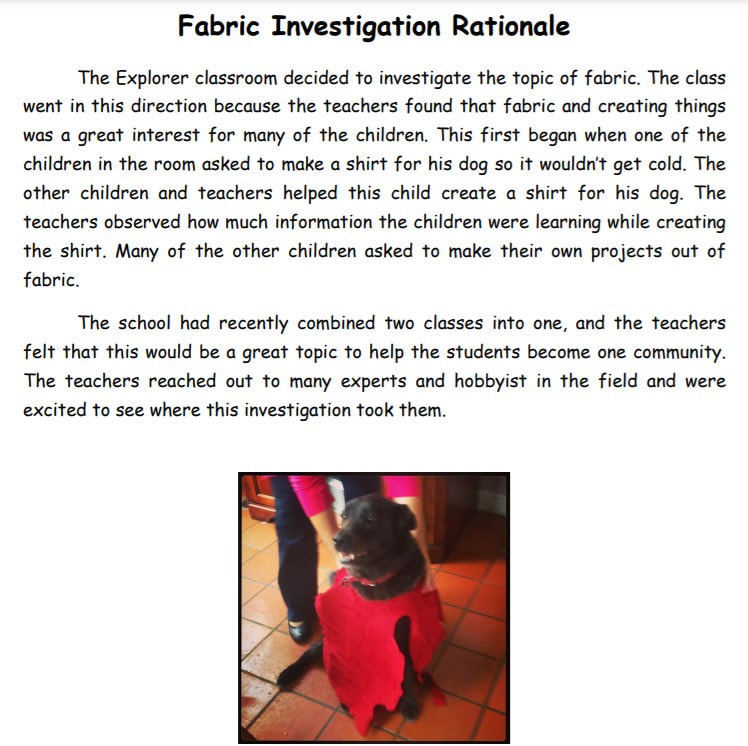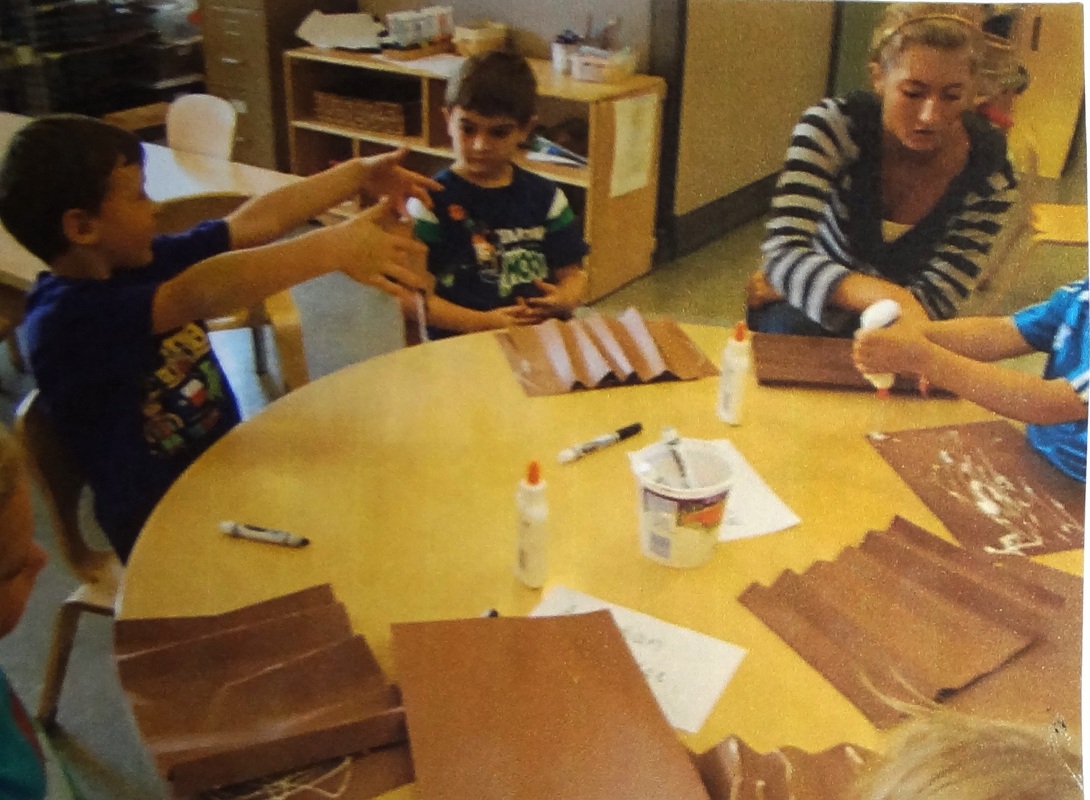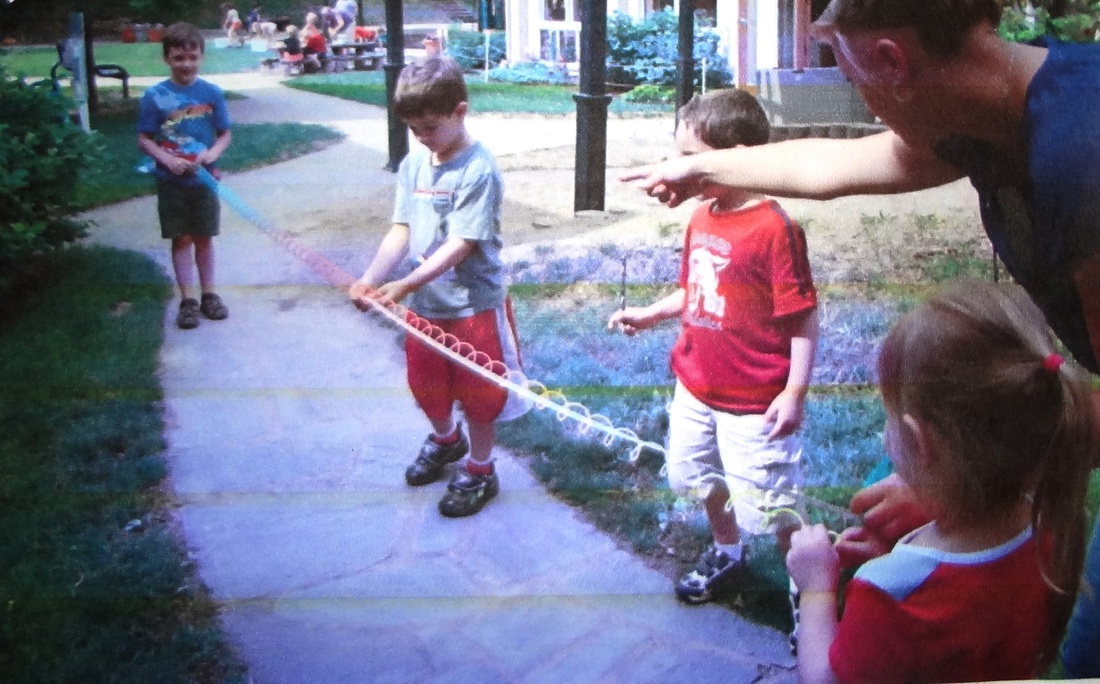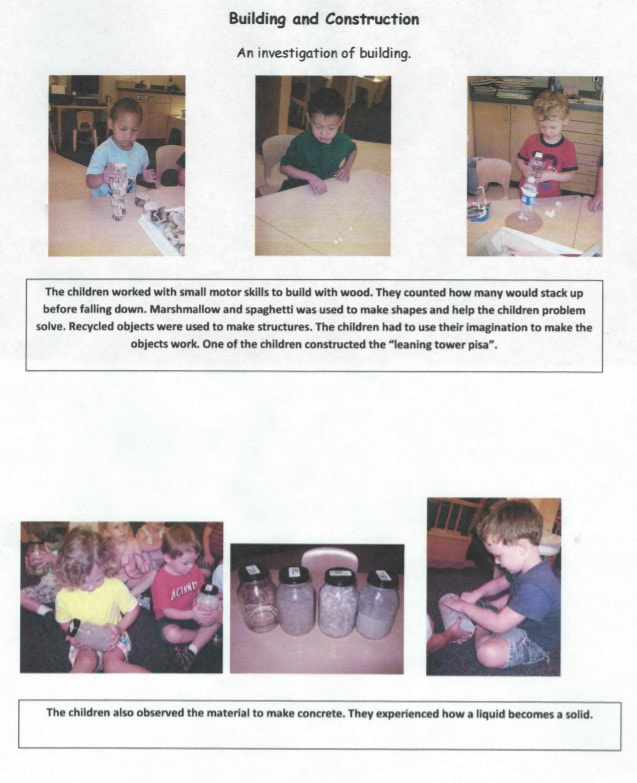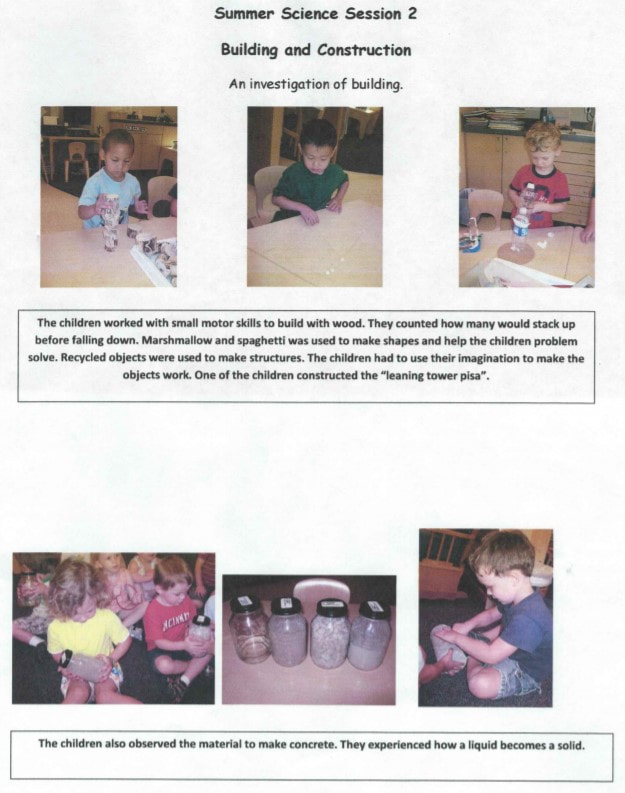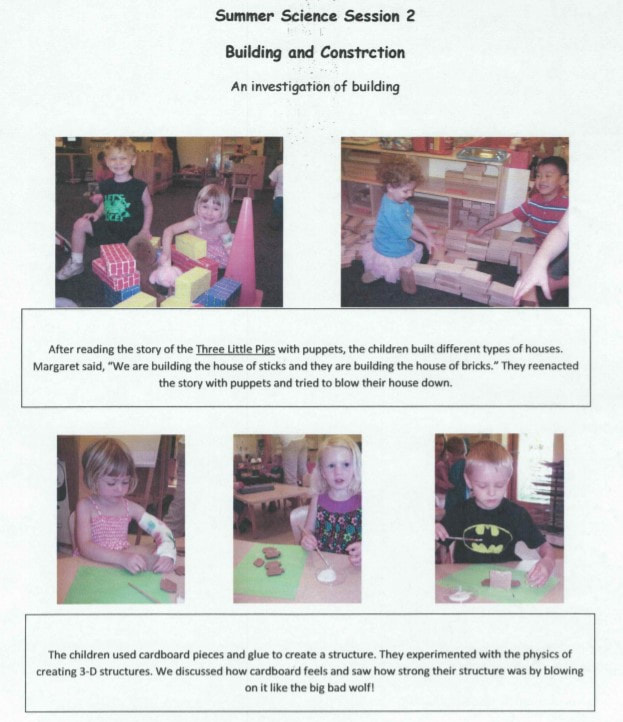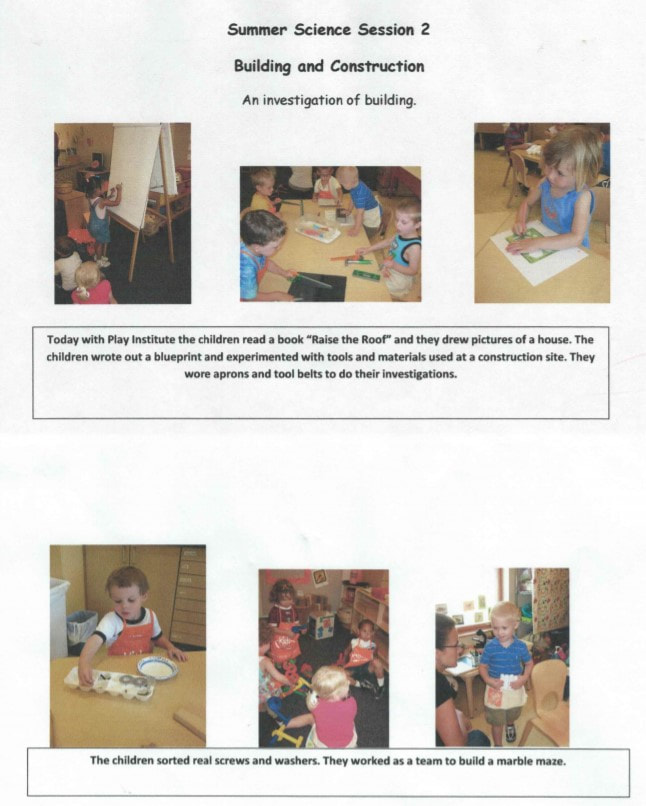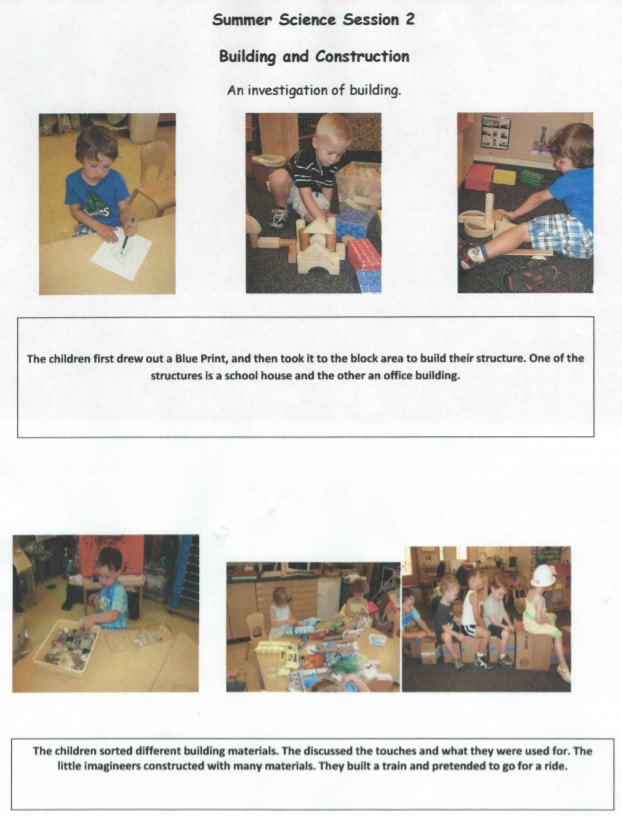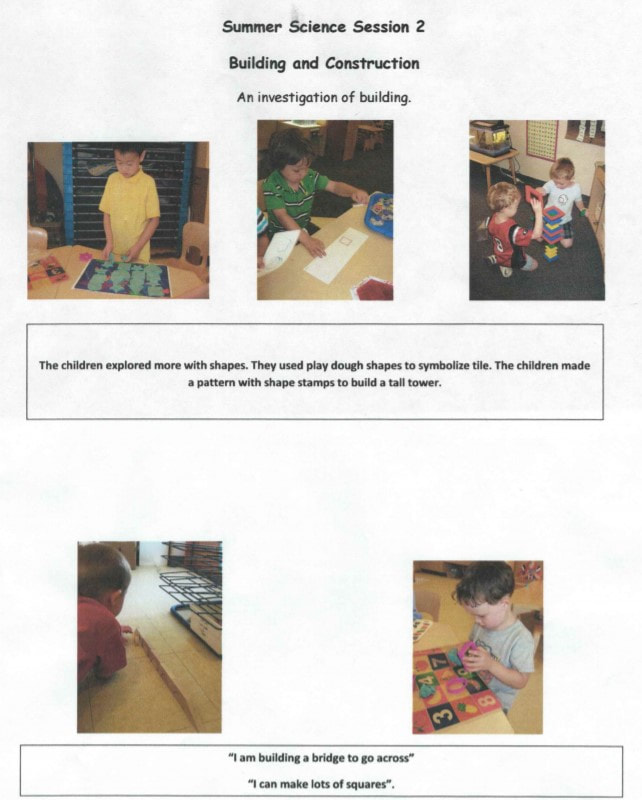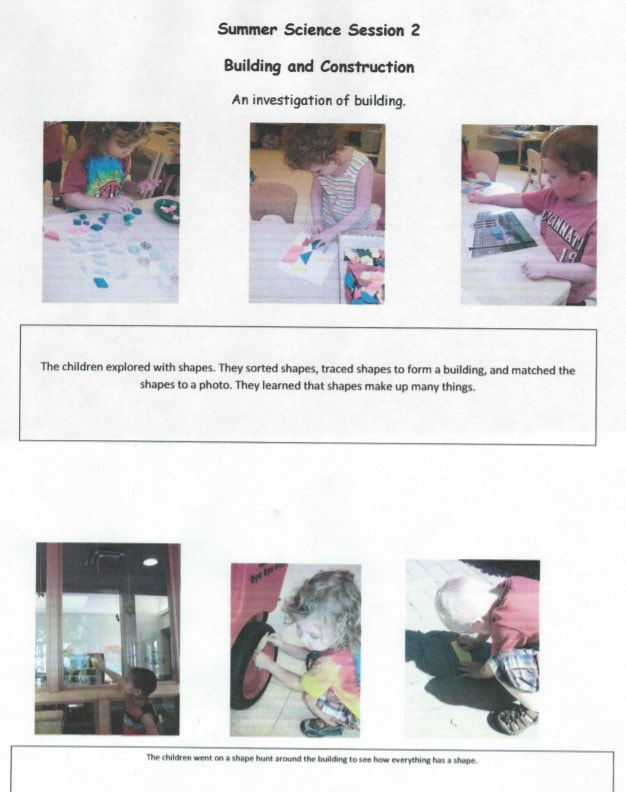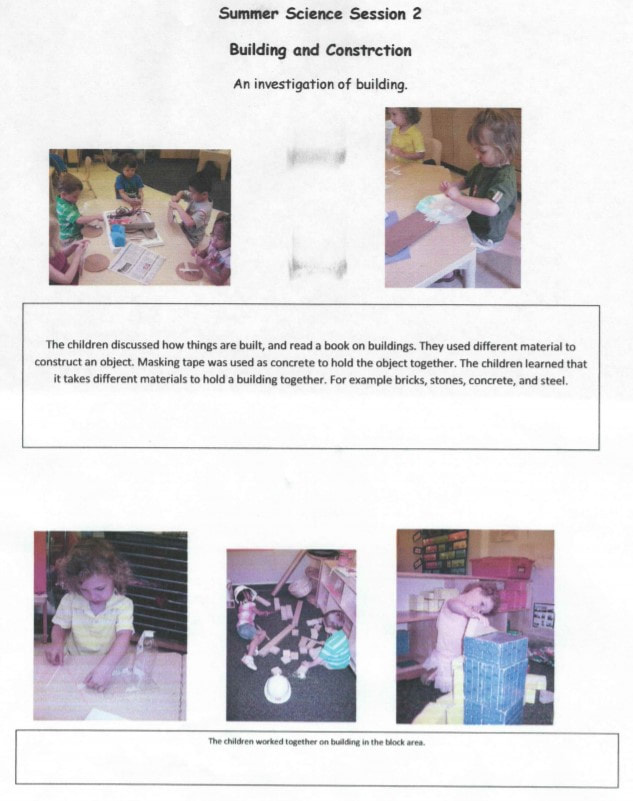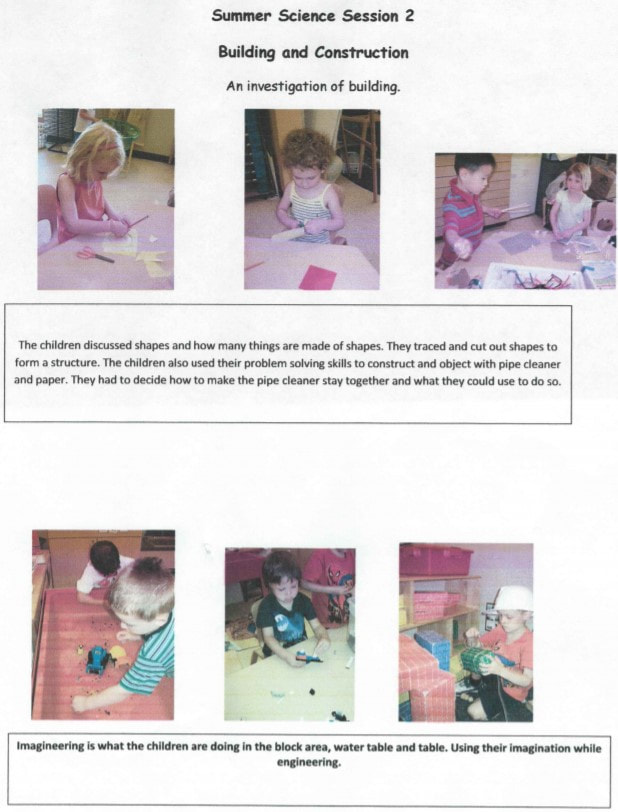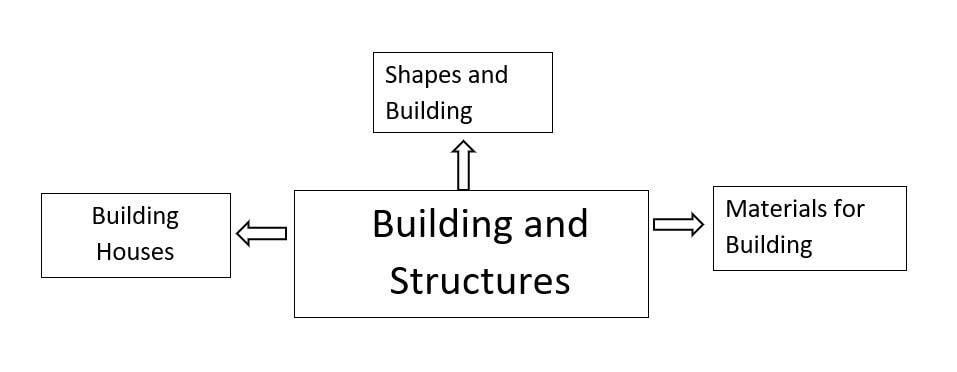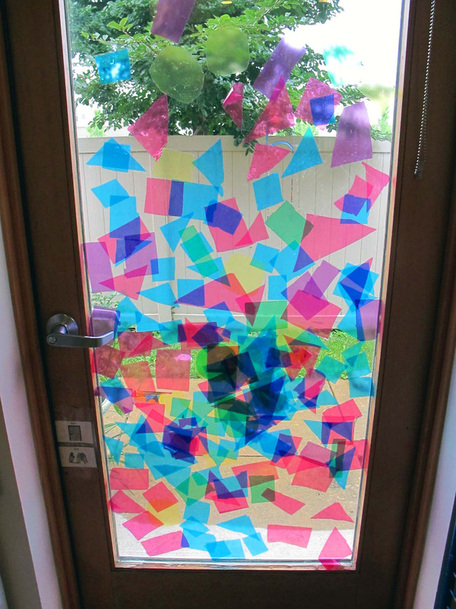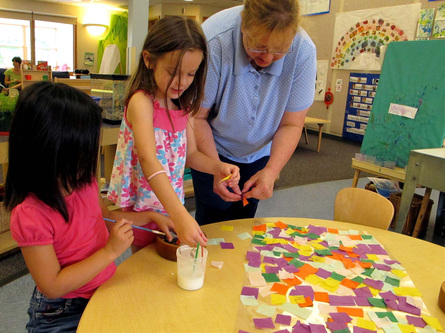STONE SOUP MINI-INVESTIGATION
Using flour and water to create a paste helps the children to compare a thinner medium that may be used for building with paper or other more flexible materials.
| Construction |
| Planning Web |
Different mediums offer different types of strength when using materials to connect pieces as the children create a big structure out of smaller parts. Using play dough helps the children to manipulate a sturdy connecting medium to build houses and barns for their animal toys out of Popsicle sticks and wood cookies.
CONSTRUCTION
| MIXTURES PORTFOLIO SHEET |
MIXTURES CULMUNATING ACTIVITY & PARENT BRUNCH
The culminating event for our investigation was the class invited the parents to help assemble various mixture bottles and to share a brunch with their child/children. The children and the parents were each given a different recipe to follow for making a shaker bottle. The items that were needed for the different recipes were located on a cart in the classroom. Each recipe covered a science concept or sensory regulation. After gathering the supplies that were needed the parents and children made their bottles together.
The culminating event for our investigation was the class invited the parents to help assemble various mixture bottles and to share a brunch with their child/children. The children and the parents were each given a different recipe to follow for making a shaker bottle. The items that were needed for the different recipes were located on a cart in the classroom. Each recipe covered a science concept or sensory regulation. After gathering the supplies that were needed the parents and children made their bottles together.
SAND PAINTING
Using a mixture of paint, sand and a variety of tools the children made paintings. First they mixed the paint and the sand together. Then using the different tools including brushes, combs and sponges ,the children made their creations.
Using a mixture of paint, sand and a variety of tools the children made paintings. First they mixed the paint and the sand together. Then using the different tools including brushes, combs and sponges ,the children made their creations.
MAKING BUTTER
Using heavy whipping cream, the children made butter to go with the pumpkin bread they were also making. The cream was put in two containers and then passed around the table so each child could shake it. The children counted to 10 and then passing the container on to the next child.
Using heavy whipping cream, the children made butter to go with the pumpkin bread they were also making. The cream was put in two containers and then passed around the table so each child could shake it. The children counted to 10 and then passing the container on to the next child.
MAKING OOBLECK
The children created a suspension of cornstarch and water called Oobleck. Oobleck acts as both a solid and a liquid depending on how much pressure is applied to the mixture. When a lot of pressure is applied it acts as a solid but when the pressure is lessened it acts like a liquid.
The children created a suspension of cornstarch and water called Oobleck. Oobleck acts as both a solid and a liquid depending on how much pressure is applied to the mixture. When a lot of pressure is applied it acts as a solid but when the pressure is lessened it acts like a liquid.
MIXING BAKING SODA WITH KETCHUP
The children conducted an experiment using baking soda and ketchup. When the two ingredients were mixed together, the mixture began to foam. The children were asked why they thought the mixture foamed, and then there was a discussion about their answers. Using prior knowledge that baking soda and vinegar foamed ,some of the children correctly deduced that there was vinegar in the ketchup.
The children conducted an experiment using baking soda and ketchup. When the two ingredients were mixed together, the mixture began to foam. The children were asked why they thought the mixture foamed, and then there was a discussion about their answers. Using prior knowledge that baking soda and vinegar foamed ,some of the children correctly deduced that there was vinegar in the ketchup.
MAKING GAK
Using glue and Borax, the children followed a recipe to make Gak. They then added watercolor to the Gak mixture.
Using glue and Borax, the children followed a recipe to make Gak. They then added watercolor to the Gak mixture.
FROZEN BAKING SODA, WATER & VINEGAR
Using a frozen baking soda and water mixture, the children put vinegar on top of the frozen discs with eye droppers to see what would happen. They were asked to predict what would happen based on their prior knowledge. The discs foamed when the vinegar touched the frozen surface.
Using a frozen baking soda and water mixture, the children put vinegar on top of the frozen discs with eye droppers to see what would happen. They were asked to predict what would happen based on their prior knowledge. The discs foamed when the vinegar touched the frozen surface.
MIXING
OIL, WATER & COLOR
Using clear jars, the children made mixtures using oil and colored water or soap and colored water. They then compared the differences between the mixtures. After they compared the mixtures, they shook the containers to see what would happen and then compared the mixtures again.
Using clear jars, the children made mixtures using oil and colored water or soap and colored water. They then compared the differences between the mixtures. After they compared the mixtures, they shook the containers to see what would happen and then compared the mixtures again.
MAKING FINGER PAINT
Using dish soap, starch and primary colored paints, the children made their own finger paints. Using the red, yellow and blue finger paint, the children then mixed 2 colors together to come up with secondary colors on paper plates and plastic trays. The children then made prints on paper of the colors they made.
Using dish soap, starch and primary colored paints, the children made their own finger paints. Using the red, yellow and blue finger paint, the children then mixed 2 colors together to come up with secondary colors on paper plates and plastic trays. The children then made prints on paper of the colors they made.
| Mixtures Concept Planner |
| Mixtures Anticipatory Web |
An activity involving making “moon sand” out of flour and oil was introduced to the class. The children enjoyed adding the flour and oil together with spoons and their hands to make the moon sand. The children were also very interested in iPad apps called Cake Pops, Cookie Maker, Sundae and Donut which involved mixing ingredients together, so the teachers decided to follow the children's interests and do a study of mixtures.
HOW THE TOPIC RELATES TO S.T.E.M.
-Deeply involves science, math, technology and engineering standards
-Is a real life/real world problem for children to investigate. Children see mixtures in everyday routines such as cooking, the tooth paste they use to brush their teeth, etc.
-Generates questions to learn through hands on experiences
-Provides hands on learning by creating real life mixtures and exploring what happens when two things mix
-Uses technology to mix ingredients, when ingredients were not available to make cakes, cookies,etc.
-Integrates content
-Requires an inquiry approach concerning materials provided in order to learn about the materials
HOW THE TOPIC RELATES TO S.T.E.M.
-Deeply involves science, math, technology and engineering standards
-Is a real life/real world problem for children to investigate. Children see mixtures in everyday routines such as cooking, the tooth paste they use to brush their teeth, etc.
-Generates questions to learn through hands on experiences
-Provides hands on learning by creating real life mixtures and exploring what happens when two things mix
-Uses technology to mix ingredients, when ingredients were not available to make cakes, cookies,etc.
-Integrates content
-Requires an inquiry approach concerning materials provided in order to learn about the materials
This investigation took place at the Bombeck Family Learning Center which is the Early Childhood Education demonstration/research school for the University of Dayton. This is the birthplace of the ACCESS Curriculum. The classroom environment consists of pre-K aged students and range ages from 3 to 5 years old. This class has approximately 20 children with 3 full time teachers as well as student teachers from the University. The room is set up for center-based learning and is divided into different areas that include the following centers/areas: dramatic play, manipulative (math) area, block area, literacy/story or book area, art center, science center and sensory tables. The room also includes 4 large tables for group work and eating meals. The classroom is child-centered and provides opportunity for children to choose where they would like to work and play. The classroom also offers each child the opportunity to make decisions on what he/she would like to engage in. The class is set up in such a way as the child chooses what learning experiences he/she would like to engage in and at what point during the day as well as the ability to move freely from experience to experience. Moreover, the class schedule creates time for children to participate in teacher directed activities in small and large groups.
MIXTURES INVESTIGATION
STUDY OF LIGHT: TRANSPERENCY
STUDY OF LIGHT: REFRACTION
STUDY OF LIGHT: REFLECTION
MIRRORS: REFLECTION
STUDY OF SHADOWS
| Just Me & My Shadow |
| Shadow & Light |
| Light |
LIGHT, SHADOW & REFLECTION INVESTIGATION
INSECTS
| Chaharshanbe Suri |
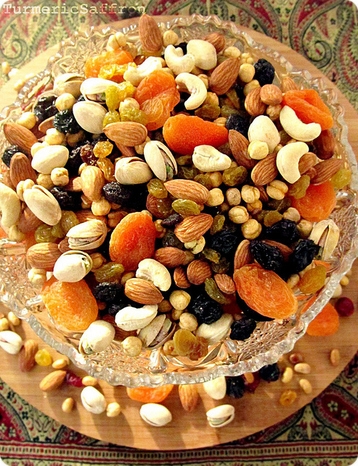
Introduced from one of our students from Iran, the children
learned about Chahārshanbe Suri which is
a fire jumping festival, celebrated in Iran and Afghanistan.
Loosely translated as Wednesday Light, from the word sur which means light in Persian or more plausibly, consider sur to be a variant of sorkh (red) and take it to refer either to the fire itself or to the ruddiness (sorkhi), meaning good health or ripeness, supposedly obtained by jumping over it, is an ancient Iranian festival dating back to at least 1700 BCE of the early Zoroastrian era. Also called the Festival of Fire, it is a prelude to Nowruz, which marks the arrival of spring. The words Chahar Shanbeh mean Wednesday and Suri means red. Bonfires are lit to "keep the sun alive" until early morning. The celebration usually starts in the evening, with people making bonfires in the streets and jumping over them singing.
Another tradition of this day is to make special ajeel, or mixed nuts and berries. People wear disguises and go door to door knocking on doors as similar to Trick-or-treating.
Loosely translated as Wednesday Light, from the word sur which means light in Persian or more plausibly, consider sur to be a variant of sorkh (red) and take it to refer either to the fire itself or to the ruddiness (sorkhi), meaning good health or ripeness, supposedly obtained by jumping over it, is an ancient Iranian festival dating back to at least 1700 BCE of the early Zoroastrian era. Also called the Festival of Fire, it is a prelude to Nowruz, which marks the arrival of spring. The words Chahar Shanbeh mean Wednesday and Suri means red. Bonfires are lit to "keep the sun alive" until early morning. The celebration usually starts in the evening, with people making bonfires in the streets and jumping over them singing.
Another tradition of this day is to make special ajeel, or mixed nuts and berries. People wear disguises and go door to door knocking on doors as similar to Trick-or-treating.
Chaharshanbe Suri Mini-Investigation
| The Three Little Pigs |
Based on the children's interest to act out a play, we decided to an investigation on a fairy tale story. The children would set up the stage on the loft area in the classroom and set up chairs for the audience to it and watch. Initially, the children struggled with acting out the words and motions. So we wanted to choose a play that we could all put on together. We saw a strong interest in animals and set up a dramatic play area as an "Animal Rescue Center." With that said, we let the children vote on a fairy tale of their choice and we would look at it through an engineering lens. The children voted and they choose The 3 Little Pigs.
THE 3 LITTLE PIGS MINI-INVESTIGATION
| Ants |
Grace, Julian and Justin discovered several ant holes. Providing simple tools like a magnifying glass helped increase the children's discovery and interest. Grace said, “Ants are coming out the ant hole.” Julian said, “Big hole under the ground.”
Providing children with opportunities to make observational drawings helps children focus and really observe details. Drawing also gives them opportunities to discuss what they see which develops verbal and social skills.
An investigation into the amazing world of ants, how they live, communicate and work.
ANT MINI-INVESTIGATION
| Trail Mix Activity |
| Cooking Activities |
The class took old crayons and broke them into smaller pieces. The pieces were put into a plastic muffin tin and then melted in the microwave. After cooling, the children drew with the new multi-colored crayons.
The children experimented with ice cubes, salt and yarn. They took a piece of ice, laid the yarn on top and sprinkled salt over the yarn. The idea was to melt the ice so that the yarn would stick to it.
Different kitchen ingredients were put in little canisters. The children then smelled the canisters and made predictions about what was in each canister.
Children used various kitchen utensils to create sand paintings. This helped them to acquire new vocabulary words such as mallet, spork, smash and spatula.
The children cut out pictures of food from different magazines. They then sorted the food into food groups.
The children made salt dough and then created 3 dimensional art pieces to go along with the story Don't Wake Up Mama by Eileen Christelow.
The children experimented with ice cubes, salt and yarn. They took a piece of ice, laid the yarn on top and sprinkled salt over the yarn. The idea was to melt the ice so that the yarn would stick to it.
Different kitchen ingredients were put in little canisters. The children then smelled the canisters and made predictions about what was in each canister.
Children used various kitchen utensils to create sand paintings. This helped them to acquire new vocabulary words such as mallet, spork, smash and spatula.
The children cut out pictures of food from different magazines. They then sorted the food into food groups.
The children made salt dough and then created 3 dimensional art pieces to go along with the story Don't Wake Up Mama by Eileen Christelow.
| Planning Web |
| Vocab Words |
| Content Standards |
KITCHEN SCIENCE INVESTIGATION
Background information, sample experiences, literacy connections and more.
http://idahoptv.org/sciencetrek/topics/simple_machines/facts.cfm
http://atlantis.coe.uh.edu/archive/science/science_lessons/scienceles1/finalhome.htm
http://camillasenior.homestead.com/review_simple_machines.pdf
Additional web links for resource materials for Simple Machines:
http://earlychildhoodscribbles.blogspot.co.uk/2013/02/exploring-machines-in-preschool.html
Ideas for a great literacy connection on force. Introduction to force to support simple machines investigation:
https://www.icanteachmychild.com/will-it-slide/
Literacy connection for ramps.
Tacky the Penguin
Introduction to how Penguins like to slide on ice.
Introduction to experiment of what will slide on ice….
https://www.teachpreschool.org/stem/engineering/
http://teachertomsblog.blogspot.com/2010/04/more-learning-about-pendulums.html
Check out teacher tom’s blog - Teaching and Learning from Preschoolers.
Read the end of the posting to see what else was going on in his classroom during the pendulum play.
https://inventorsoftomorrow.com/2016/10/26/simple-machines-engineering-for-kids/
This site provides background information on simple machines and force, suggested books for children, songs, videos, games and Apps and more.
http://munchkinsandmoms.com/investigating-levers-with-preschoolers/
http://kidsactivitiesblog.com/12676/simple-machines-pulley
http://littlebinsforlittlehands.com/pvc-pipe-pully-kids-simple-machines-stem-activity/
https://es.pinterest.com/pin/55450639142193907/?lp=true
http://ecrp.uiuc.edu/v17n1/cowan.html
(excellent documentation of an extended project on wheels conducted in a junior/kindergarten-kindergarten classroom - from the ECRP Early Childhood Research & Practice journal – a per reviewed multilingual journal on the development, care, and education of young children
http://illinoisearlylearning.org/illinoispip/guides/
Wheels an in-depth documentation of a Project Approach investigation.
http://idahoptv.org/sciencetrek/topics/simple_machines/facts.cfm
http://www.momshavequestionstoo.com/lifting-simple-machines-science-saturday-blog-hop/
http://idahoptv.org/sciencetrek/topics/simple_machines/facts.cfm
http://atlantis.coe.uh.edu/archive/science/science_lessons/scienceles1/finalhome.htm
http://camillasenior.homestead.com/review_simple_machines.pdf
Additional web links for resource materials for Simple Machines:
http://earlychildhoodscribbles.blogspot.co.uk/2013/02/exploring-machines-in-preschool.html
Ideas for a great literacy connection on force. Introduction to force to support simple machines investigation:
https://www.icanteachmychild.com/will-it-slide/
Literacy connection for ramps.
Tacky the Penguin
Introduction to how Penguins like to slide on ice.
Introduction to experiment of what will slide on ice….
https://www.teachpreschool.org/stem/engineering/
http://teachertomsblog.blogspot.com/2010/04/more-learning-about-pendulums.html
Check out teacher tom’s blog - Teaching and Learning from Preschoolers.
Read the end of the posting to see what else was going on in his classroom during the pendulum play.
https://inventorsoftomorrow.com/2016/10/26/simple-machines-engineering-for-kids/
This site provides background information on simple machines and force, suggested books for children, songs, videos, games and Apps and more.
http://munchkinsandmoms.com/investigating-levers-with-preschoolers/
http://kidsactivitiesblog.com/12676/simple-machines-pulley
http://littlebinsforlittlehands.com/pvc-pipe-pully-kids-simple-machines-stem-activity/
https://es.pinterest.com/pin/55450639142193907/?lp=true
http://ecrp.uiuc.edu/v17n1/cowan.html
(excellent documentation of an extended project on wheels conducted in a junior/kindergarten-kindergarten classroom - from the ECRP Early Childhood Research & Practice journal – a per reviewed multilingual journal on the development, care, and education of young children
http://illinoisearlylearning.org/illinoispip/guides/
Wheels an in-depth documentation of a Project Approach investigation.
http://idahoptv.org/sciencetrek/topics/simple_machines/facts.cfm
http://www.momshavequestionstoo.com/lifting-simple-machines-science-saturday-blog-hop/
| 6 Types of Simple Machines |
| SIMPLE MACHINES BLANK PORTFOLIO PAGE |
| DPS SIMPLE MACHINES CONCEPT FLOW CHART |
| SIMPLE MACHINES SCIENCE CONCEPT PLANNER |
Every day we use simple machines without even thinking about it. Children use simple machines when using scissors to cut paper, turn the cap on a container, and playing with cars. They experience them in their everyday life. The children in the Voyager room began creating simple machines with blocks and connectors during their play. Through this project the children will learn how simple machines help make work easier. When a simple machine is used to complete a task less effort is used. They will have the opportunity to explore the concepts of force, objects in motion, and friction on objects.
SIMPLE MACHINES INVESTIGATION
| METAL INVESTIGATION PORTFOLIO PAGES |
FUSING BEADS WITH HEAT
During our metal investigation, the children explored the process of using heat to melt materials together. They made designs with beads and added heat from an iron to fuse them together.
During our metal investigation, the children explored the process of using heat to melt materials together. They made designs with beads and added heat from an iron to fuse them together.
EXPLORING WAYS TO STICK METAL TOGETHER
During our metal investigation the children explored metal objects by building structures with them. While building many children noticed that their structures were falling over. They wanted to find a way to get metal objects to stick together. The children suggested items such as tape and glue. After viewing some videos of metal being fused together with heat, the children found that welding or soldering metal with high heat is the best way to get 2 pieces of metal to stick together.
During our metal investigation the children explored metal objects by building structures with them. While building many children noticed that their structures were falling over. They wanted to find a way to get metal objects to stick together. The children suggested items such as tape and glue. After viewing some videos of metal being fused together with heat, the children found that welding or soldering metal with high heat is the best way to get 2 pieces of metal to stick together.
MAKING CREATIONS WITH METAL
Using paper clips, buttons, and beads, the children made a variety of creations. They unbent the paperclips and used their small motor control as well as eye-hand coordination they string the buttons and beads onto paperclips.
Using paper clips, buttons, and beads, the children made a variety of creations. They unbent the paperclips and used their small motor control as well as eye-hand coordination they string the buttons and beads onto paperclips.
TEARING APART OBJECTS THAT CONTAIN METAL
An old metal drill, a hair dryer and a radio were put out for the children to take apart using wrenches, screw drivers, pliers and other tools. The children used their fine motor control and eye-hand coordination to take the items apart. They took turns and had to figure out what tool would work the best. They examined the pieces as they took them apart and determined what pieces were made of metal.
An old metal drill, a hair dryer and a radio were put out for the children to take apart using wrenches, screw drivers, pliers and other tools. The children used their fine motor control and eye-hand coordination to take the items apart. They took turns and had to figure out what tool would work the best. They examined the pieces as they took them apart and determined what pieces were made of metal.
USING A MAP TO DOCUMENT WHERE METAL WAS FOUND IN THE ROOM
While investigating metal, the children explored the uses of metal by going on a metal search in the classroom and school. When they found metal, they recorded the location by marking it on the map of the classroom and school.
While investigating metal, the children explored the uses of metal by going on a metal search in the classroom and school. When they found metal, they recorded the location by marking it on the map of the classroom and school.
EXPERIMENTING WITH HAMMERING PLASTIC, WOOD & METAL ITEMS
Using plastic pegs, wood golf tees and nails, the children experimented with hammering the items into wooden boards. The children predicted and observed which items would be easier to hammer into the board (the nails) and which items would break or crack and splinter (the plastic pegs and golf tees).
Using plastic pegs, wood golf tees and nails, the children experimented with hammering the items into wooden boards. The children predicted and observed which items would be easier to hammer into the board (the nails) and which items would break or crack and splinter (the plastic pegs and golf tees).
BUILDING WITH METAL OBJECTS
Over the course of several days, the children built metal creations using different metal objects that had been collected. After building their creations the children both drew and painted their creations. The children had to coordinate the use of their hands, fingers and wrists to manipulate objects in order to build their creations. They then had to demonstrate self-direction to develop and carry out a simple plan to both draw and paint their creations.
Over the course of several days, the children built metal creations using different metal objects that had been collected. After building their creations the children both drew and painted their creations. The children had to coordinate the use of their hands, fingers and wrists to manipulate objects in order to build their creations. They then had to demonstrate self-direction to develop and carry out a simple plan to both draw and paint their creations.
PAINTING WITH METAL CANS
Using metal cans, a ramp and paint, the children explored the position and motion of the objects. The children dipped the cans into different colors of paint and then placed them at the top of a ramp. They let go of the can and observed the marks the can left as it rolled down the ramp.
Using metal cans, a ramp and paint, the children explored the position and motion of the objects. The children dipped the cans into different colors of paint and then placed them at the top of a ramp. They let go of the can and observed the marks the can left as it rolled down the ramp.
USING A VICE TO UNDERSTAND THAT METAL IS MALLEABLE
To help expand the children's understanding that metal is malleable, the children put different plastic, wood and metal items into a vice. The children then closed the vice to test whether the items could be bent and was malleable or if the item cracked and/or broke and therefore was NOT malleable.
To help expand the children's understanding that metal is malleable, the children put different plastic, wood and metal items into a vice. The children then closed the vice to test whether the items could be bent and was malleable or if the item cracked and/or broke and therefore was NOT malleable.
TEARING & CUTTING FOIL INTO PIECES & CREATING SHAPES
Using their fine motor skills, the children traced shapes onto a piece of paper. Using their eye-hand coordination, the children applied glue to the shape they traced. Using small pieces of aluminum foil they had previously cut, the children placed the foil onto the glued outline of the shape they had drawn. Doing this helped the children focus on an activity with deliberate concentration and to carry out simple plans to obtain a goal.
Using their fine motor skills, the children traced shapes onto a piece of paper. Using their eye-hand coordination, the children applied glue to the shape they traced. Using small pieces of aluminum foil they had previously cut, the children placed the foil onto the glued outline of the shape they had drawn. Doing this helped the children focus on an activity with deliberate concentration and to carry out simple plans to obtain a goal.
PAINTING & DRAWING ON FOIL WITH MARKERS
The children drew and painted on aluminum foil. This allowed them to use their imagination and creativity to interact with the materials. The children experienced how the different mediums worked on the foil.
The children drew and painted on aluminum foil. This allowed them to use their imagination and creativity to interact with the materials. The children experienced how the different mediums worked on the foil.
PUNCHING SHAPE HOLES INTO FOIL & PAINTING WITH WATERCOLORS
Using shaped stencils, the children used their fine motor skills to punch holes into aluminum foil. After the holes were punched into the foil, the children placed the foil on top of a piece of white paper. The children painted on top of the foil then removed it to see their creations. This activity focused on the children's ability to stay with an activity from beginning to end.
Using shaped stencils, the children used their fine motor skills to punch holes into aluminum foil. After the holes were punched into the foil, the children placed the foil on top of a piece of white paper. The children painted on top of the foil then removed it to see their creations. This activity focused on the children's ability to stay with an activity from beginning to end.
HAMMERING NAILS INTO FOIL
Using their eye-hand coordination, the children pounded nails into pieces of foil. The children also explored the position and motion of the hammer, nails and foil as well as exploring the properties of these objects.
Using their eye-hand coordination, the children pounded nails into pieces of foil. The children also explored the position and motion of the hammer, nails and foil as well as exploring the properties of these objects.
MAKING BRACELETS & USING METAL BEADS
Using metal pipe cleaners and beads, the children made bracelets. The children used their fine motor skills and coordination of their fingers and hands to string the beads onto the pipe cleaners. They also work on counting and patterning skills while making their creations.
Using metal pipe cleaners and beads, the children made bracelets. The children used their fine motor skills and coordination of their fingers and hands to string the beads onto the pipe cleaners. They also work on counting and patterning skills while making their creations.
WRITING THE WORD "METAL" WITH ALUMINIUM FOIL
Using small pieces of aluminum foil that the children cut and tore ,they glued the foil pieces onto the letters to create and spell the word "METAL." Doing this helped the children understand that letters are a special category of symbols that are part of writing. It also helped demonstrate letter formation.
Using small pieces of aluminum foil that the children cut and tore ,they glued the foil pieces onto the letters to create and spell the word "METAL." Doing this helped the children understand that letters are a special category of symbols that are part of writing. It also helped demonstrate letter formation.
USING FOAM LETTERS TO WRITE WORDS THAT RELATE TO METAL
Using foam letters, the children wrote words that relate to metal. The children chose a word to write and then located the foam letters that they needed to create the word from a tray of letters. The children glued the letters on to their papers. This helped the children realize that one letter or a cluster of letters represent one word. It also required them to use their small motor skills to find the letters they needed and glue them onto the paper.
Using foam letters, the children wrote words that relate to metal. The children chose a word to write and then located the foam letters that they needed to create the word from a tray of letters. The children glued the letters on to their papers. This helped the children realize that one letter or a cluster of letters represent one word. It also required them to use their small motor skills to find the letters they needed and glue them onto the paper.
SORTING BY MATERIAL: PAPER, PLASTIC, GLASS, WOOD, & METAL
Given a variety of objects, the children were asked to sort them by the type of material they were made of. The children were asked to look at the objects, feel them and decide which category they belonged in: wood, plastic, metal, glass or paper. They then placed the items into categories.
Given a variety of objects, the children were asked to sort them by the type of material they were made of. The children were asked to look at the objects, feel them and decide which category they belonged in: wood, plastic, metal, glass or paper. They then placed the items into categories.
MAKING LETTERS WITH PIPE CLEANERS
Using pipe cleaners the children demonstrated letter formation by bending the pipe cleaners to make upper and lower case letters. This helped the children understand that letters are a special category of symbols and aided in the recognition of some upper and lower case letters.
Using pipe cleaners the children demonstrated letter formation by bending the pipe cleaners to make upper and lower case letters. This helped the children understand that letters are a special category of symbols and aided in the recognition of some upper and lower case letters.
CREATIONING FROM WIRE & PIPE CLEANERS
Using thin wire and pipe cleaners, the children explored the malleable characteristic of metal by making creations using blocks, dowel rods and other objects to bend and manipulate the wire and pipe cleaners into a variety of shapes. The children used their imaginations and creativity to interact with the materials and objects.
Using thin wire and pipe cleaners, the children explored the malleable characteristic of metal by making creations using blocks, dowel rods and other objects to bend and manipulate the wire and pipe cleaners into a variety of shapes. The children used their imaginations and creativity to interact with the materials and objects.
DISCOVERING IF IT IS METAL?
A variety of objects were placed on the table for the children to examine and compare. A chart titled "Is it Metal?" was placed on the table. The children were asked guided questions to help them determine whether each object was metal or not. The children then placed the objects on the chart according to whether they thought it was metal or not.
A variety of objects were placed on the table for the children to examine and compare. A chart titled "Is it Metal?" was placed on the table. The children were asked guided questions to help them determine whether each object was metal or not. The children then placed the objects on the chart according to whether they thought it was metal or not.
DISCOVERING METAL INSIDE OF PIPE CLEANERS
Using scissors the children cut the chenille part of the pipe cleaners off to discover what was at the center of the pipe cleaner. The children were asked what they discovered in the center. Their responses included "wire and metal." The children then manipulated the pipe cleaners by bending them into different shapes, letters and jewelry such as bracelets
Using scissors the children cut the chenille part of the pipe cleaners off to discover what was at the center of the pipe cleaner. The children were asked what they discovered in the center. Their responses included "wire and metal." The children then manipulated the pipe cleaners by bending them into different shapes, letters and jewelry such as bracelets
CUTTING & TEARING FOIL
The children used their small motor skills to tear and/or cut aluminum foil into small pieces to be used for a later activity where they would be making letters out of foil pieces. The children had to coordinate their hands and wrists to manipulate the scissors to be able to cut or tear the foil.
The children used their small motor skills to tear and/or cut aluminum foil into small pieces to be used for a later activity where they would be making letters out of foil pieces. The children had to coordinate their hands and wrists to manipulate the scissors to be able to cut or tear the foil.
| METAL SCIENCE CONCEPT PLANNER |
APPROACHES TOWARD LEARNING
-Focus on an activity with deliberate concentration despite distractions
-Carry out tasks, activities, projects or experiences from beginning to end
-Ask questions to seek explanations about phenomena of interest
SOCIAL EMOTIONAL
-Engage in extended, reciprocal conversations with familiar adults
MOTOR DEVELOPMENT
-Coordinate the use of hands, fingers and wrists to manipulate objects and perform tasks requiring precise movements
-Use classroom and household tools independently with eye-hand coordination to carry out activities
-Focus on an activity with deliberate concentration despite distractions
-Carry out tasks, activities, projects or experiences from beginning to end
-Ask questions to seek explanations about phenomena of interest
SOCIAL EMOTIONAL
-Engage in extended, reciprocal conversations with familiar adults
MOTOR DEVELOPMENT
-Coordinate the use of hands, fingers and wrists to manipulate objects and perform tasks requiring precise movements
-Use classroom and household tools independently with eye-hand coordination to carry out activities
SCIENCE
-Explore objects, materials and events in the environment
-Make careful observations
-Use simple tools to extend investigation
-With modeling and support, explore the properties of objects and materials
-With modeling and support, explore the position and motion of objects
MATH
-Sort and classify objects by one or more attributes
-Collect data by categories to answer simple questions
LANGUAGE & LITERACY
-Demonstrate understanding of increasingly complex concepts and longer sentences
-With modeling and support, determine the meanings of unknown words/concepts using the context of conversations
-Explore objects, materials and events in the environment
-Make careful observations
-Use simple tools to extend investigation
-With modeling and support, explore the properties of objects and materials
-With modeling and support, explore the position and motion of objects
MATH
-Sort and classify objects by one or more attributes
-Collect data by categories to answer simple questions
LANGUAGE & LITERACY
-Demonstrate understanding of increasingly complex concepts and longer sentences
-With modeling and support, determine the meanings of unknown words/concepts using the context of conversations
STANDARDS ADDRESSED
The topic of metal was chosen because the children were very interested in building structures and wearing jewelry while dressing up in the classroom's home living center. Through the study of metal we will be able to tap into both interests. This topic was also selected because it was innovative and we could focus on properties, characteristics and uses of metal through various hands on activities. These experiences provided children with opportunities to use inquiry skills to discover concepts related to metal. Moreover, we focused on ferromagnetic metals with magnets and explored which metals rust, corrode and tarnish.
HOW THE TOPIC RELATES TO S.T.E.M.
-Deeply involves science math technology engineering standards
-Is a real life/real world problem for children to investigate, metal is found in many objects that children use on a daily basis
-Provides hands on learning opportunities for children as they manipulate, fuse, and turn metal into wire while generating questions about what they discover.
-Uses technology by watching YouTube videos of welding and soldering since it cannot be brought into the classroom
-Employs engineering process when making creations with metal
-Uses an integrated approach
HOW THE TOPIC RELATES TO S.T.E.M.
-Deeply involves science math technology engineering standards
-Is a real life/real world problem for children to investigate, metal is found in many objects that children use on a daily basis
-Provides hands on learning opportunities for children as they manipulate, fuse, and turn metal into wire while generating questions about what they discover.
-Uses technology by watching YouTube videos of welding and soldering since it cannot be brought into the classroom
-Employs engineering process when making creations with metal
-Uses an integrated approach
METAL INVESTIGATION
| Tools |
| Field Trip |
| Blocks |
| Measuring Materials |
| Planning Web |
CONSTRUCTION INVESTIGATION
| Field Trip Photos |
| Sew Dayton |
"Can we borrow some fabric?"-Oliver
"Do you have a pattern that makes rainbows?"-James
"Where is the corduroy fabric in the store?"-Erica and Cohen
"Where do you get all of this fabric?"
"Do you have a pattern that makes rainbows?"-James
"Where is the corduroy fabric in the store?"-Erica and Cohen
"Where do you get all of this fabric?"
To further their investigation, the Explorers took a field trip to Sew Dayton, , a local sewing shop, to get some hands-on experience with the material they were learning about. Before the trip, the teachers asked the children what they desired to learn from the experience and the questions they had for the experts at Sew Dayton.
FIELD EXPERIENCE
| Under the Microscope |
| Researching our Ideas |
| Lacing |
| Feely Box |
| Planning our Ideas |
| Working with a Loom |
| Weaving |
| Making our Ideas |
The children sewed strips of fabric onto a large sewing board. The teachers wanted to add color to the board, so they painted a big sheet of paper and had plans to cut it into strips. After the paper dried, it was so beautiful that they instead decided to keep the sheet of paper in one piece.
FABRIC PROJECTS
To help the children get a better look at fabric, the teachers put out microscopes for the children to use with fabric swatches. With the help of the microscopes, the children observed the different patterns and shapes that the fabrics were made of. The children worked to draw what they were seeing under the microscope. The children drew squares and lines to represent the fabrics up close. They also watched a movie about weaving, had the opportunity to create their own weaving on cardboard, worked with lacing cards, and explored the way fabric feels by reaching inside a "feely box".
As part of the investigation, each child was asked to create a fabric item using the sewing machine. As part of this project, the children had to first come up with something they wanted to create, and then decide how they would create it by using research. See the documents below that outlines this project of the investigation.
When the Explorers Classroom first began talking about fabric during circle time, many of the students did not know what fabric was. The classroom discussed during circle time that the clothes the students and teachers had on were fabric as well as the clothes and blankets in the home center. To help the students get a better idea of what fabric was and what it felt like, the teachers put out different types of fabric for the children to explore and work with. The children looked at all the fabrics they put out. Some children tried to add the fabrics to their clothes and some laid out the fabrics in different ways to make people and designs.
During circle time the class talked about the tags in their shirts and what they are made of. The children had the opportunity to look at their tags and find out what fabric their shirts were made of. Then they drew a picture of their shirts.
"Can we make a parachute out of fabric?" –Eli
"Can we make dresses out of fabric?" –Oliver
"Can you make kittens out of fabric?" -Eloïse
"Can we make dresses out of fabric?" –Oliver
"Can you make kittens out of fabric?" -Eloïse
"My jacket is made of fabric." –Ben
"My pillow is made of fabric." –Coen
"It gets glue on it to make different things." –James
"My pillow is made of fabric." –Coen
"It gets glue on it to make different things." –James
WHAT DO YOU KNOW ABOUT FABRIC?
The Explorers' teachers asked the children what they already knew about fabric and what information they wanted to learn from the investigation.
The Explorer classroom decided to investigate the topic of fabric. The class went in this direction because the teachers found that fabric-making and creating things with fabric is a great interest for many of the children. This first began when one of the children in the room asked to make a shirt for his dog so she would not get cold. The other children and teachers helped this child create such a shirt for his dog. The teachers observed how much information the children were learning about while trying to create this shirt. The teachers also observed how many of the other children were interested in this project who then also began to make their own projects out of fabric.
ENGINEERING FABRIC
The children make "cable" for the suspension bridge by twisting together 3 small strings into one large cable.
The children create a beam with an "accordion" deck. A deck that has triangles between the decks. The children place objects on this bridge to test its strength. The children then record the objects the bridge will hold. The children use a graph to compare the strengths of all three bridges: BEAM, ARCH and ACCORDIAN
We had a relay race to see which team could compress sponges to put the most water in the buckets.
We measured Slinky's before and after tension was applied. We discussed how compression makes things smaller and tension makes things longer and the effects these forces have on bridges.
ENGINEERING BRIDGES
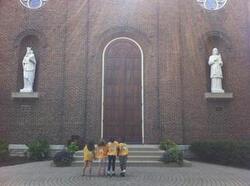
A walk on campus provided the children a direct experience with building structures like the chapel and the law building. Clipboards and pencils were provided to the children so they could record their observations. The children's discussions of shapes and various parts like windows, steps, doors, statues, etc., enhanced their knowledge and enabled them to start planning their own future structures.
Experiences Included
BUILDING & STRUCTURES INVESTIGATION
PURPOSE
During group time the children discussed the people who are involved in building structures. They also compared and contrasted the job of a construction worker versus an architect. The children further investigated the purpose of structures by constructing their own structures with blocks and then adding the appropriate doll furniture items to add purpose. Using a model they refined their letter formation skills by making a list of different types of buildings using a model. The children also chose a magazine clipping of a building and wrote the purpose of the building. Through this experience the children were able to demonstrate their ability to cluster letters to make words.
During group time the children discussed the people who are involved in building structures. They also compared and contrasted the job of a construction worker versus an architect. The children further investigated the purpose of structures by constructing their own structures with blocks and then adding the appropriate doll furniture items to add purpose. Using a model they refined their letter formation skills by making a list of different types of buildings using a model. The children also chose a magazine clipping of a building and wrote the purpose of the building. Through this experience the children were able to demonstrate their ability to cluster letters to make words.
CONSTRUCTION WORKER
Builds a house
Use shapes
Build
Wood-build
Builds schools
Makes things so that they don’t fall down
Builds a house
Use shapes
Build
Wood-build
Builds schools
Makes things so that they don’t fall down
ARCHITECT
Plans
Puts stuff in house
Think about
Draw plans
Draws plan for building
Makes the words and draws house
Plans
Puts stuff in house
Think about
Draw plans
Draws plan for building
Makes the words and draws house
PURPOSE
During the beginning of our architecture investigation, the children refined their fine motor skills by cutting out pictures of structures from magazines. The children drew on their past experiences and made a representational drawing of what a building looked like to them and gave a definition of architecture/building design. While looking through pictures of famous buildings, the children discussed similarities and differences of the aesthetics of the structures.
During the beginning of our architecture investigation, the children refined their fine motor skills by cutting out pictures of structures from magazines. The children drew on their past experiences and made a representational drawing of what a building looked like to them and gave a definition of architecture/building design. While looking through pictures of famous buildings, the children discussed similarities and differences of the aesthetics of the structures.
WHAT IS ARCHITECTURE? WHAT DO YOU KNOW ABOUT BUILDINGS?
Kate- “Draw the things you want to build. It’s where you have to listen to the book.”
Jaylin- “I don’t know.”
Avery- “I don’t know. They can be tall. They have a ton of windows.”
Nahla- “Buildings.”
Liliana- “Is like a castle looks like a tall building. It’s like you see something looks that tall building outside.”
Jackson- “I don’t know. It has a bunch of windows.”
Violet- “House, drawing houses.”
Brooklyn- “Is when house like buildings. They want together all the workers and build really tall buildings.”
Landon- “Means you build something like a house or highway fill in the trench and build pipes.”
Maya- “It’s something that is maybe that lives in a city or something.”
Penny- “Like making different kind of buildings.”
Jade- “Draw like a whole bunch of windows and skyscrapers.”
Hagen- “Square on top at the house.”
Claire- “It's buildings that are really big.”
Ezra- “Drawing buildings.”
Quinn- “You do art, there is windows.”
Kaya- “You paint and you draw something, is a house or a tall building.”
Elena- “She helps makes mommy’s babies out in the hospital.”
Kate- “Draw the things you want to build. It’s where you have to listen to the book.”
Jaylin- “I don’t know.”
Avery- “I don’t know. They can be tall. They have a ton of windows.”
Nahla- “Buildings.”
Liliana- “Is like a castle looks like a tall building. It’s like you see something looks that tall building outside.”
Jackson- “I don’t know. It has a bunch of windows.”
Violet- “House, drawing houses.”
Brooklyn- “Is when house like buildings. They want together all the workers and build really tall buildings.”
Landon- “Means you build something like a house or highway fill in the trench and build pipes.”
Maya- “It’s something that is maybe that lives in a city or something.”
Penny- “Like making different kind of buildings.”
Jade- “Draw like a whole bunch of windows and skyscrapers.”
Hagen- “Square on top at the house.”
Claire- “It's buildings that are really big.”
Ezra- “Drawing buildings.”
Quinn- “You do art, there is windows.”
Kaya- “You paint and you draw something, is a house or a tall building.”
Elena- “She helps makes mommy’s babies out in the hospital.”
| Architecture Science Concept Planner |
Science:
-Make careful observations.
-Record observations using words, pictures, charts, graphs, etc.
-Describe, compare, sort, classify, and order.
-With modeling and support, explore the properties of objects and materials.
-With modeling and support, explore the position and motion of objects.
Language & Literacy:
-With modeling and support, print letters of own name and other meaningful words with mock letters and some actual letters.
-With modeling and support, use words acquired through conversations and shared reading.
Approaches Towards Learning:
-Develop, initiate and carry out simple plans to obtain a goal.
-Use creative and flexible thinking to solve problems.
-Use imagination and creativity to interact with objects and materials.
-Focus on an activity with deliberate concentration despite distractions.
-Carry out tasks, activities, projects or experiences from beginning to end.
Social Emotional:
-Show confidence in own abilities and accomplish routine and familiar tasks independently.
-Make careful observations.
-Record observations using words, pictures, charts, graphs, etc.
-Describe, compare, sort, classify, and order.
-With modeling and support, explore the properties of objects and materials.
-With modeling and support, explore the position and motion of objects.
Language & Literacy:
-With modeling and support, print letters of own name and other meaningful words with mock letters and some actual letters.
-With modeling and support, use words acquired through conversations and shared reading.
Approaches Towards Learning:
-Develop, initiate and carry out simple plans to obtain a goal.
-Use creative and flexible thinking to solve problems.
-Use imagination and creativity to interact with objects and materials.
-Focus on an activity with deliberate concentration despite distractions.
-Carry out tasks, activities, projects or experiences from beginning to end.
Social Emotional:
-Show confidence in own abilities and accomplish routine and familiar tasks independently.
Cognitive:
-Communicate about past events and anticipate what comes next during familiar routines and experiences.
-With modeling and support remember and use information for a variety of purposes.
-Recreate complex ideas, events/situations with personal adaptations.
-Demonstrate understanding that symbols carry meaning and use symbols to represent thinking.
-Participate cooperatively in complex pretend play, involving assigned roles and an overall plan.
-Demonstrate ability to solve everyday problems based upon past experience.
-Solve problems by planning and carrying out a sequence of actions.
-Seek more than one solution to a question, problem or task.
Math:
-Count to 20 by ones with increasing accuracy.
-Demonstrate one to one correspondence when counting objects up to 10.
-Collect data by categories to answer simple questions.
-Measure length and volume using non-standard or standard measurement tools.
-Create shapes during play by building, drawing, etc.
-Combine simple shapes to form larger shapes.
-Demonstrate understanding of the relative position of objects
-Sort and classify objects by one or more attributes.
-Count to solve simple addition and subtraction problems with totals smaller than 8, using concrete objects.
-Communicate about past events and anticipate what comes next during familiar routines and experiences.
-With modeling and support remember and use information for a variety of purposes.
-Recreate complex ideas, events/situations with personal adaptations.
-Demonstrate understanding that symbols carry meaning and use symbols to represent thinking.
-Participate cooperatively in complex pretend play, involving assigned roles and an overall plan.
-Demonstrate ability to solve everyday problems based upon past experience.
-Solve problems by planning and carrying out a sequence of actions.
-Seek more than one solution to a question, problem or task.
Math:
-Count to 20 by ones with increasing accuracy.
-Demonstrate one to one correspondence when counting objects up to 10.
-Collect data by categories to answer simple questions.
-Measure length and volume using non-standard or standard measurement tools.
-Create shapes during play by building, drawing, etc.
-Combine simple shapes to form larger shapes.
-Demonstrate understanding of the relative position of objects
-Sort and classify objects by one or more attributes.
-Count to solve simple addition and subtraction problems with totals smaller than 8, using concrete objects.
STANDARDS ADDRESSED
Architecture is both the
process and the product of planning, designing and constructing buildings
and other physical structures.
Architecture has to do with planning, designing and constructing form, space and ambience to reflect functional, technical, social, environmental and aesthetic considerations. It requires the creative manipulation and coordination of materials and technology, and of light and shadow.
Collaboration among architects and educators emphasizing building, inventing and creating over memorizing is key. Architectural design brings culture, agriculture, sustainability, heritage, art, science and engineering to the
'knowing eye" of children; thereby sharpening their perception, increasing their discernment and allowing children to discover the power of their own learning. Since architecture is a spatial form of art, it is crucial to study it three-dimensionally, involving all the senses.
Architecture utilizes a wide range of methods but emphasizes 3D working methods which have proved to be very effective in learning to understand the built environment. By building miniature models and 1:1 scale, children can make discoveries by themselves instead of being given answers by adults.
Children are encouraged to use all their senses in experiencing architecture. The human scale and the role of the body in experiencing the physical world form a basis for teaching. The interplay of imagination and intelligence, theory and experimentation are encouraged in project work.
Learning occurs through play and carefully planned project work. Play is the means by which children explore the world and learn naturally. A playful approach enables children to use their inborn imagination and to utilize their natural spontaneity. This contributes to the development of creativity and spatial thought processes. Experiencing success is a crucial element in all learning. Succeeding encourages one to explore the subject further.
HOW THE TOPIC RELATES TO S.T.E.M.
-Deeply involvement with science math technology engineering standards
-Is a real life/real world problem for children to investigate. Each day we spend time in structures that architects planned, and children spend much of their imagining a plan and building structures with blocks
-Provides hands on learning. The children discover that architects create plans for others while building structures with blocks. Children find that they solve many similar problems that architects solve in their work.
-Uses the engineering process by imagining an idea, drawing a blue print, and then creating as well as going back to the blue print to make changes
-Employs inquiry
-Requires integrated approach
Architecture has to do with planning, designing and constructing form, space and ambience to reflect functional, technical, social, environmental and aesthetic considerations. It requires the creative manipulation and coordination of materials and technology, and of light and shadow.
Collaboration among architects and educators emphasizing building, inventing and creating over memorizing is key. Architectural design brings culture, agriculture, sustainability, heritage, art, science and engineering to the
'knowing eye" of children; thereby sharpening their perception, increasing their discernment and allowing children to discover the power of their own learning. Since architecture is a spatial form of art, it is crucial to study it three-dimensionally, involving all the senses.
Architecture utilizes a wide range of methods but emphasizes 3D working methods which have proved to be very effective in learning to understand the built environment. By building miniature models and 1:1 scale, children can make discoveries by themselves instead of being given answers by adults.
Children are encouraged to use all their senses in experiencing architecture. The human scale and the role of the body in experiencing the physical world form a basis for teaching. The interplay of imagination and intelligence, theory and experimentation are encouraged in project work.
Learning occurs through play and carefully planned project work. Play is the means by which children explore the world and learn naturally. A playful approach enables children to use their inborn imagination and to utilize their natural spontaneity. This contributes to the development of creativity and spatial thought processes. Experiencing success is a crucial element in all learning. Succeeding encourages one to explore the subject further.
HOW THE TOPIC RELATES TO S.T.E.M.
-Deeply involvement with science math technology engineering standards
-Is a real life/real world problem for children to investigate. Each day we spend time in structures that architects planned, and children spend much of their imagining a plan and building structures with blocks
-Provides hands on learning. The children discover that architects create plans for others while building structures with blocks. Children find that they solve many similar problems that architects solve in their work.
-Uses the engineering process by imagining an idea, drawing a blue print, and then creating as well as going back to the blue print to make changes
-Employs inquiry
-Requires integrated approach
This investigation took place at the Bombeck Family Learning Center which is the Early Childhood Education demonstration/research school for the University of Dayton. This is the birthplace of the ACCESS Curriculum. The classroom environment consists of pre-K aged students and range ages from 3 to 5 years old. This class has approximately 20 children with 3 full time teachers as well as student teachers from the University. The room is set up for center-based learning and is divided into different areas that include the following centers/areas: dramatic play, manipulative (math) area, block area, literacy/story or book area, art center, science center and sensory tables. The room also includes 4 large tables for group work and eating meals. The classroom is child-centered and provides opportunity for children to choose where they would like to work and play. The classroom also offers each child the opportunity to make decisions on what he/she would like to engage in. The class is set up in such a way as the child chooses what learning experiences he/she would like to engage in and at what point during the day as well as the ability to move freely from experience to experience. Moreover, the class schedule creates time for children to participate in teacher directed activities in small and large groups.
ARCHITECTURE INVESTIGATION
| Textures |
| Chihuly |
The children learned ample new information and improved in many different areas of their development by:
-exploring the mixing of two colors to create a new color
-learning about primary and secondary colors
-learning about items that are transparent, translucent, and opaque
-developing fine motor skills through various art projects
-expanding their vocabulary through the use of new words
-discussing the difference between 2-D and 3-D objects
-having the opportunity to practice using tools safely
-working on activities in groups to achieve common goals
-exploring the mixing of two colors to create a new color
-learning about primary and secondary colors
-learning about items that are transparent, translucent, and opaque
-developing fine motor skills through various art projects
-expanding their vocabulary through the use of new words
-discussing the difference between 2-D and 3-D objects
-having the opportunity to practice using tools safely
-working on activities in groups to achieve common goals
The Voyagers classroom investigated the world of color and form and how materials can be molded and changed.





